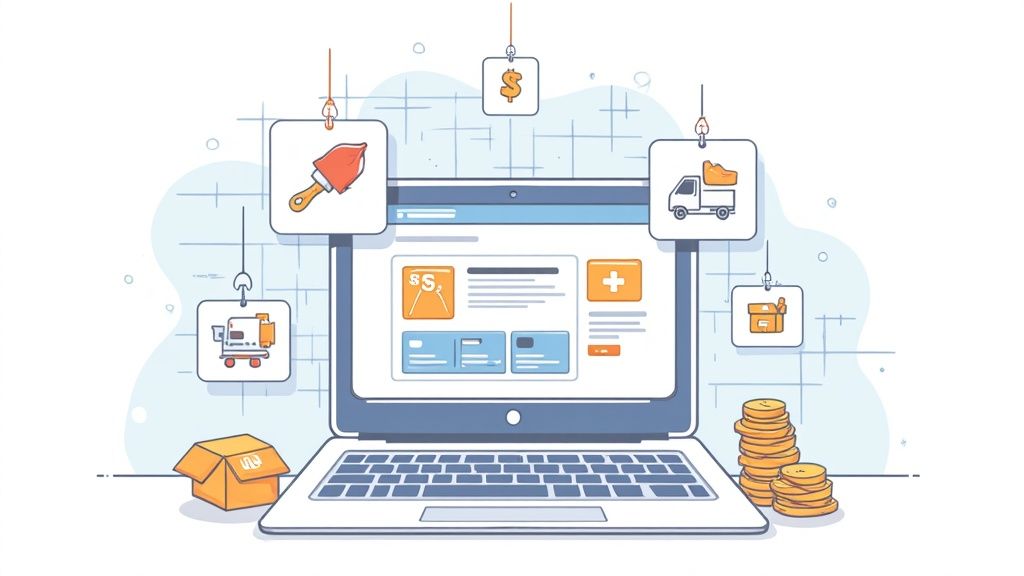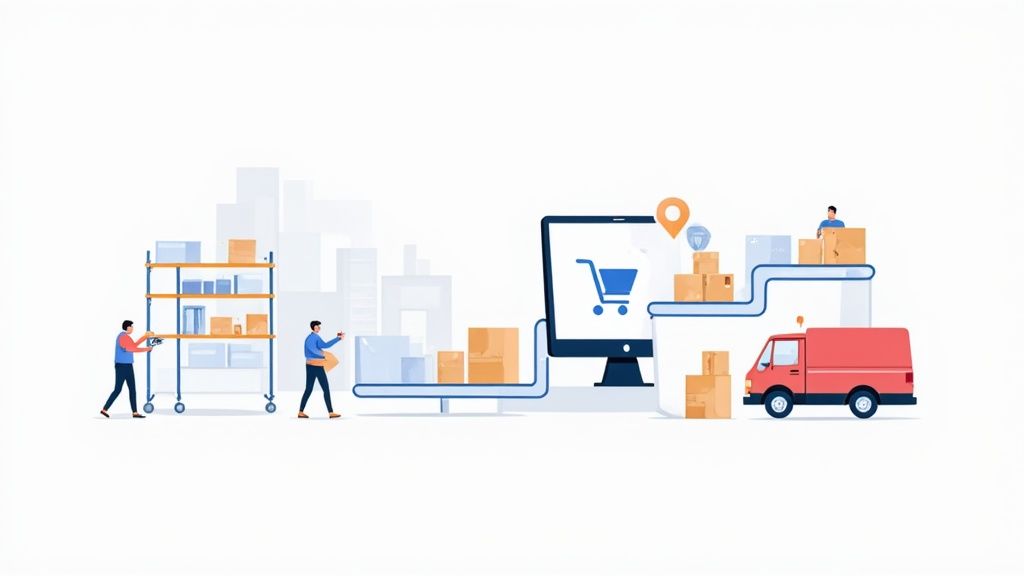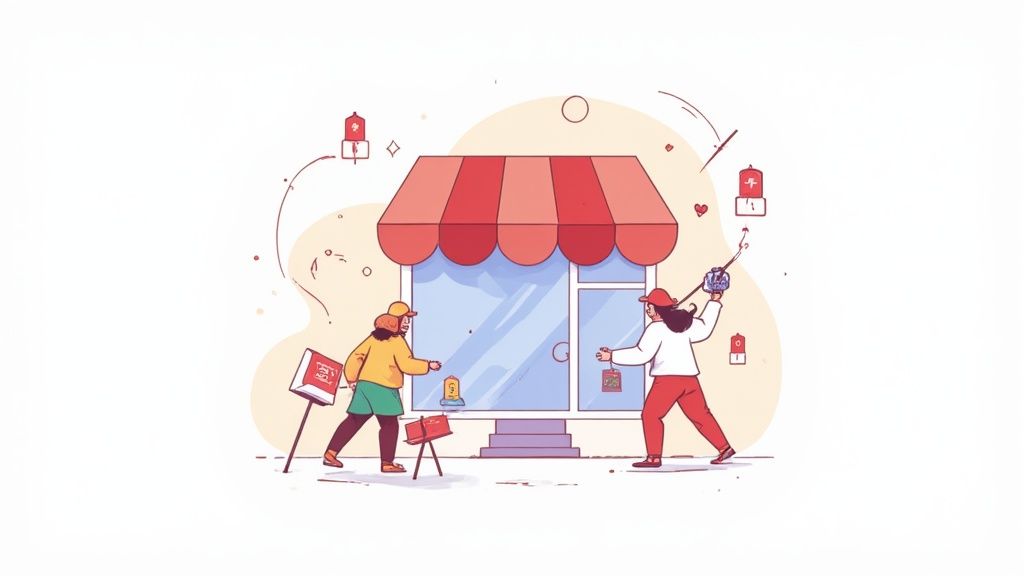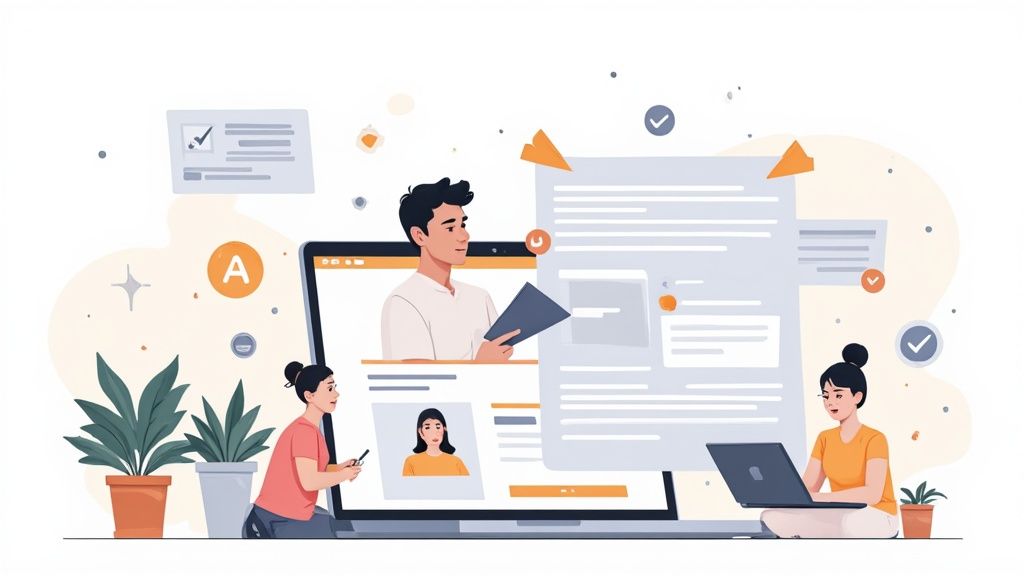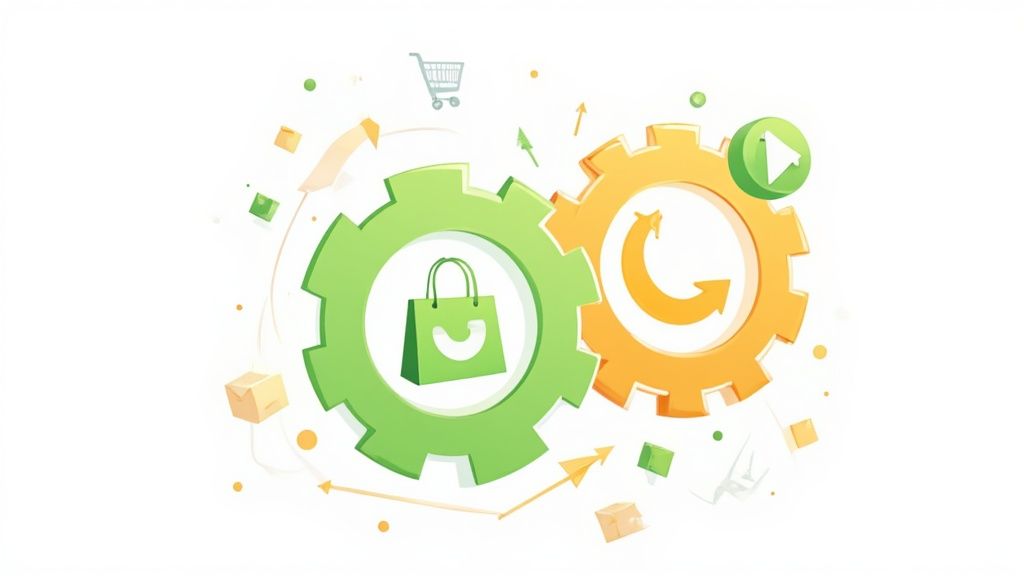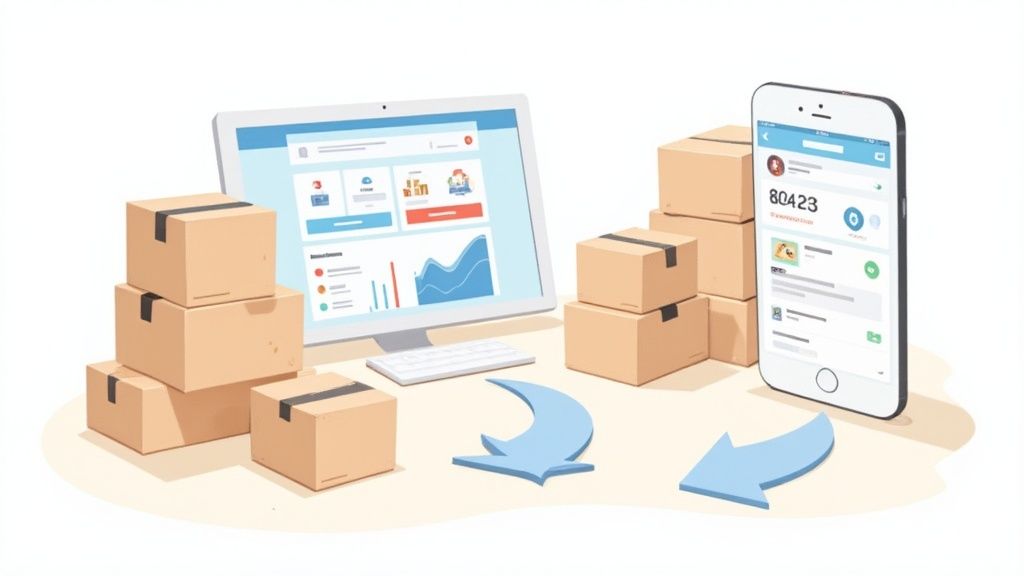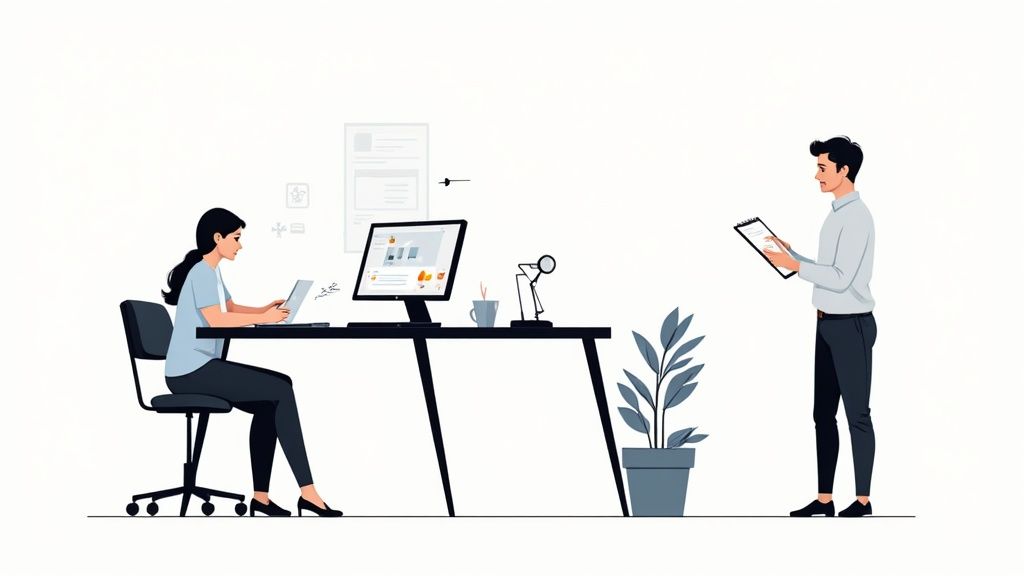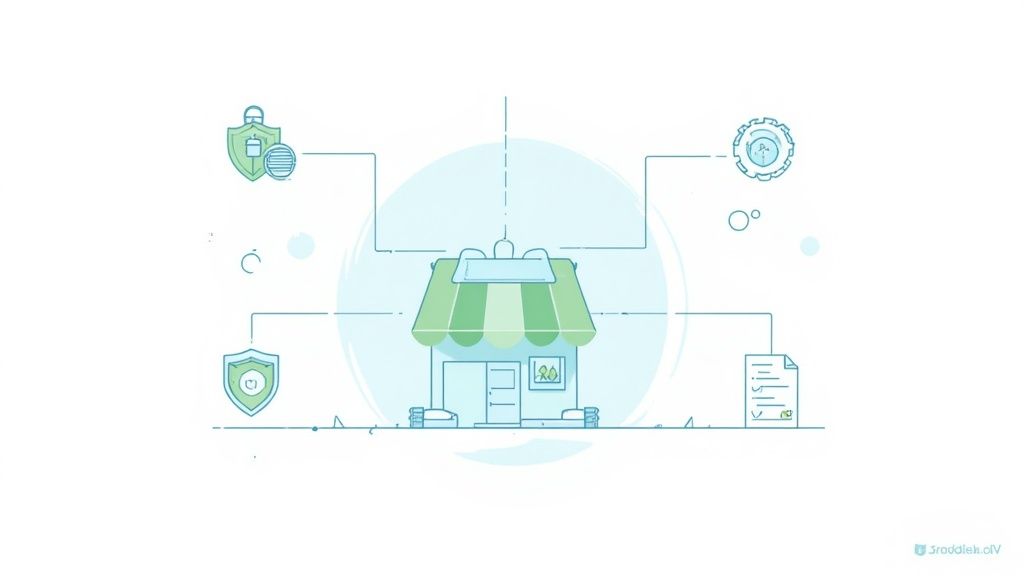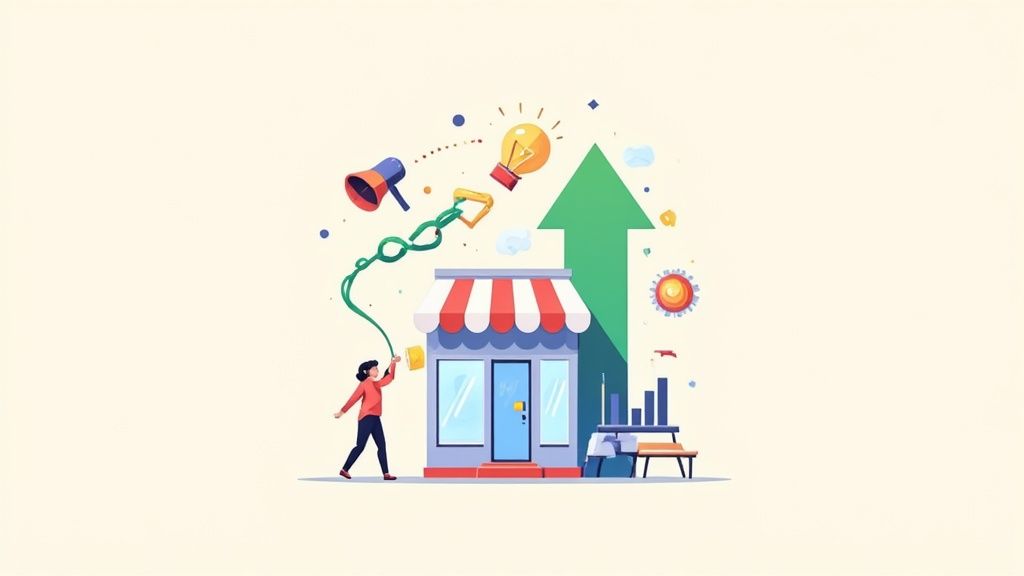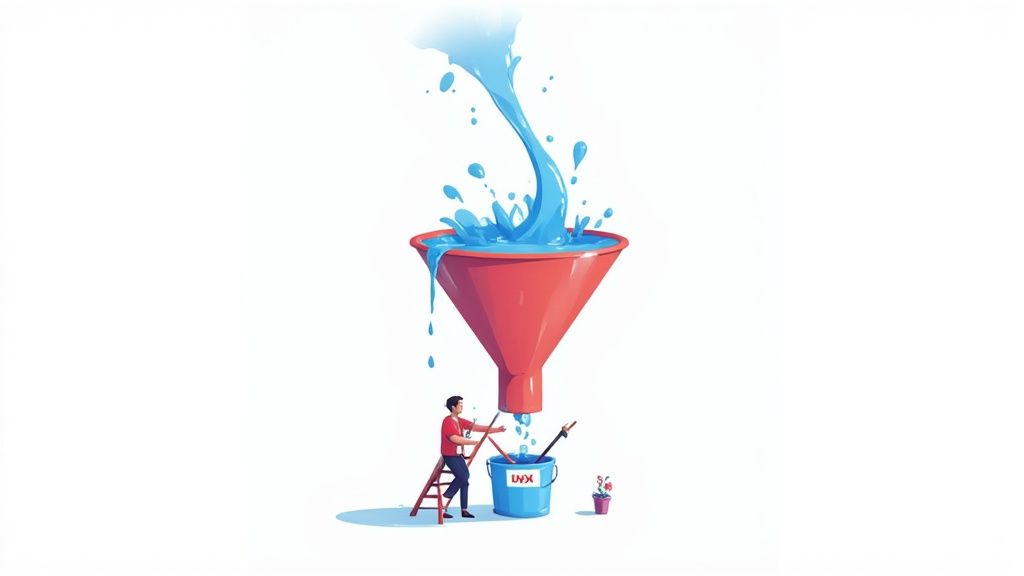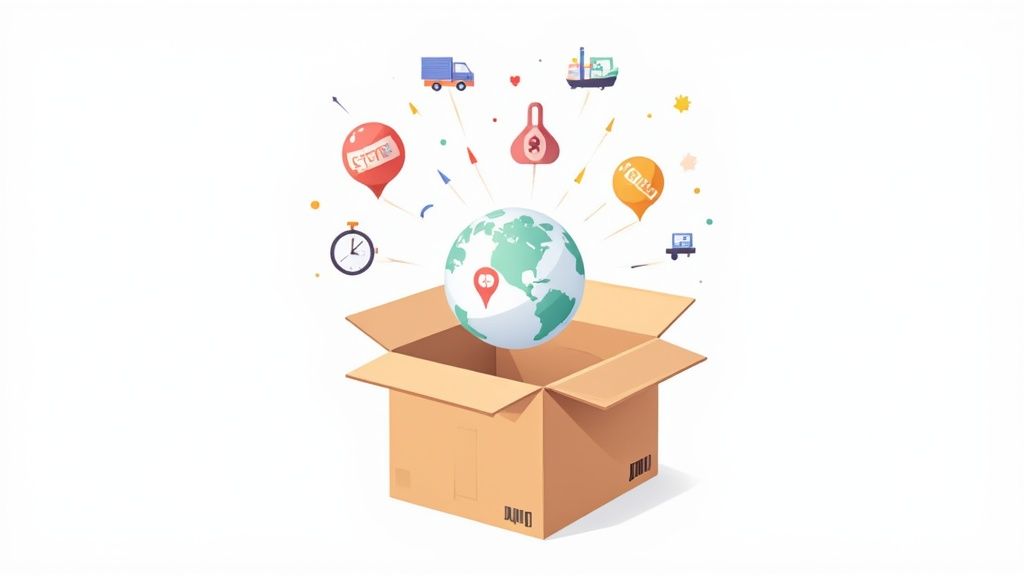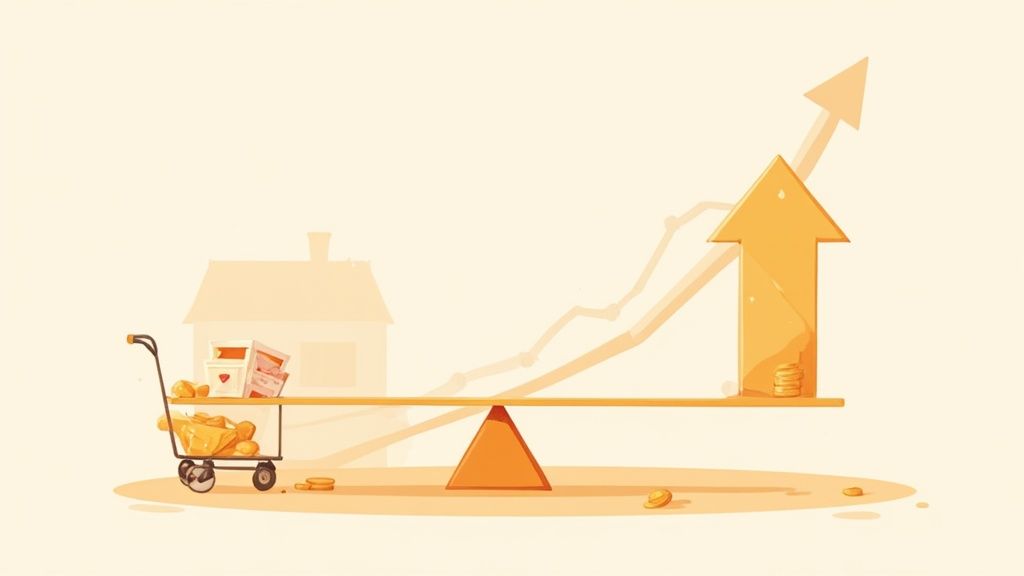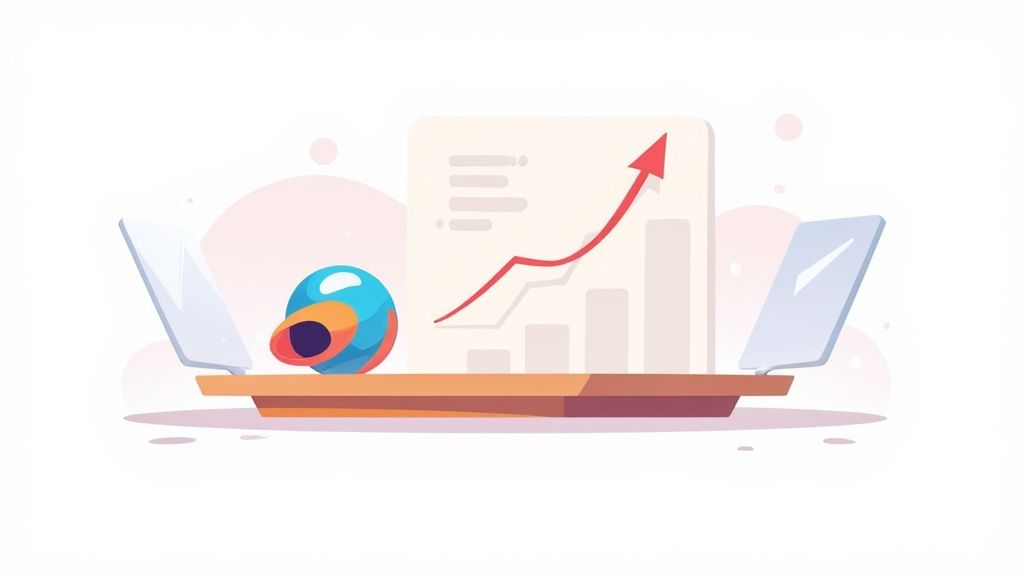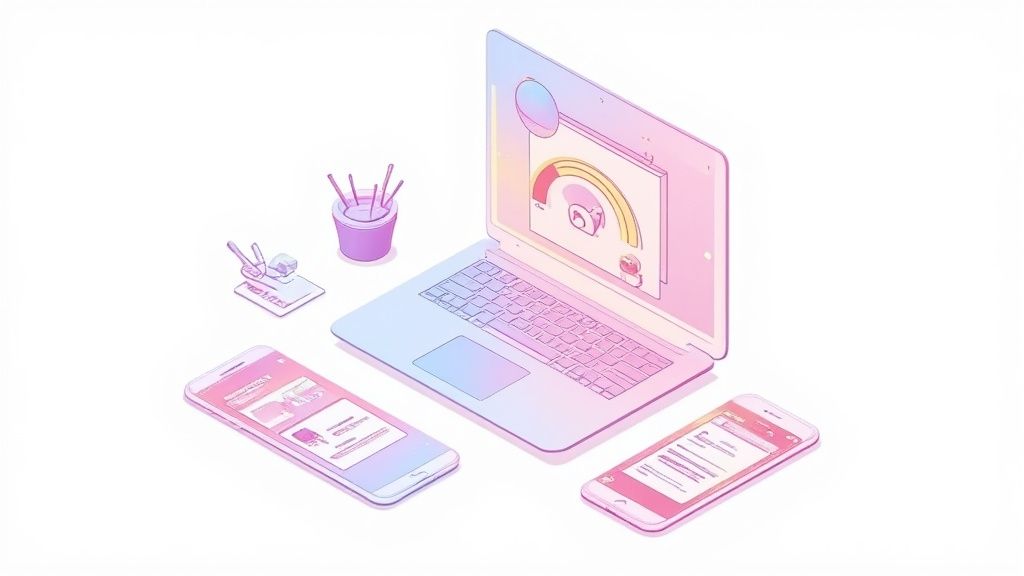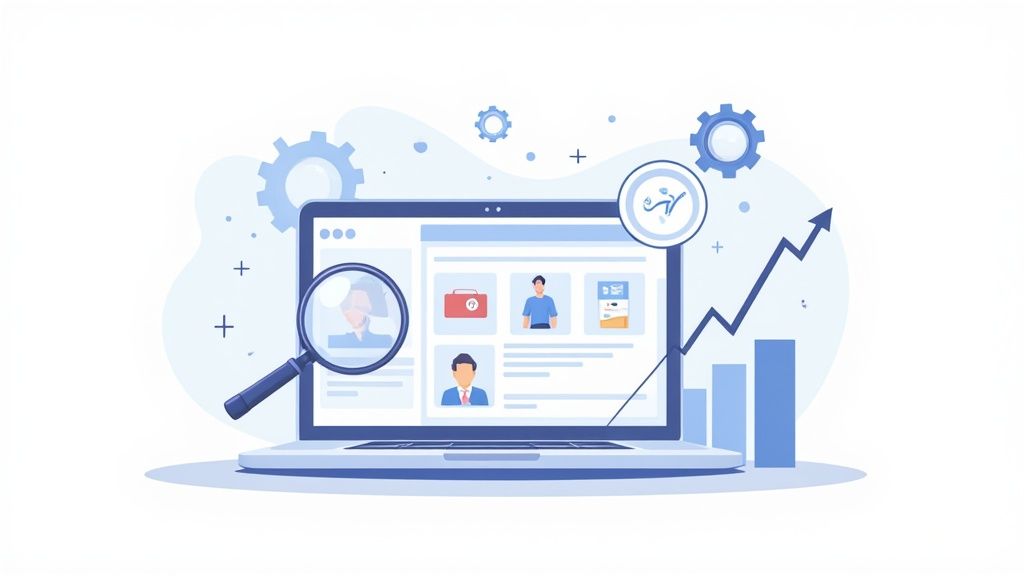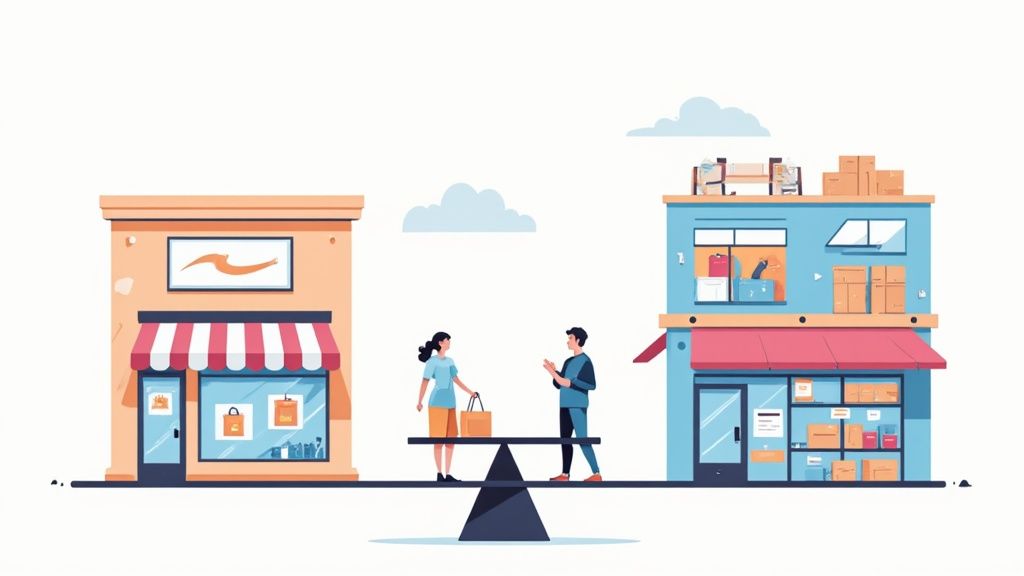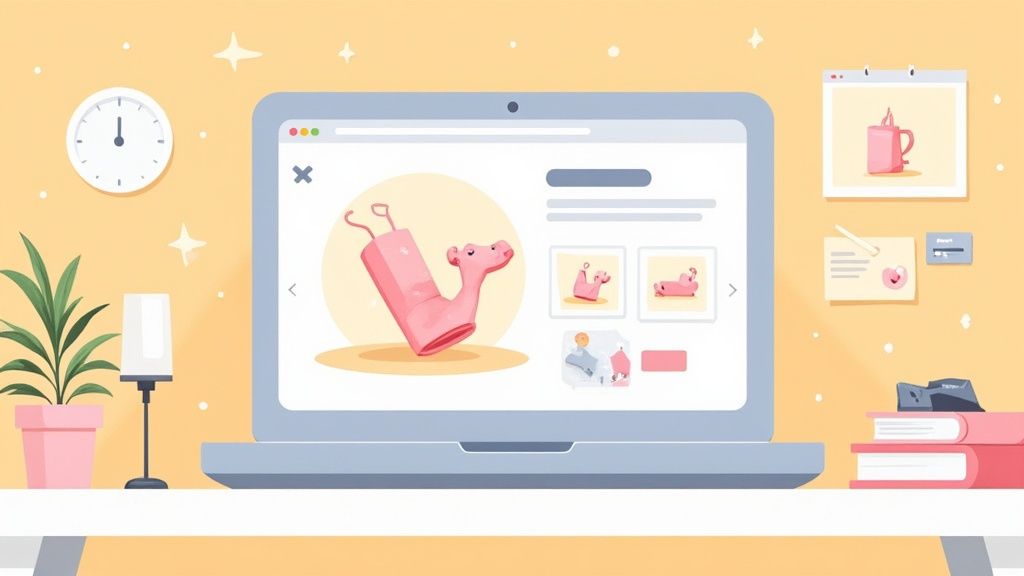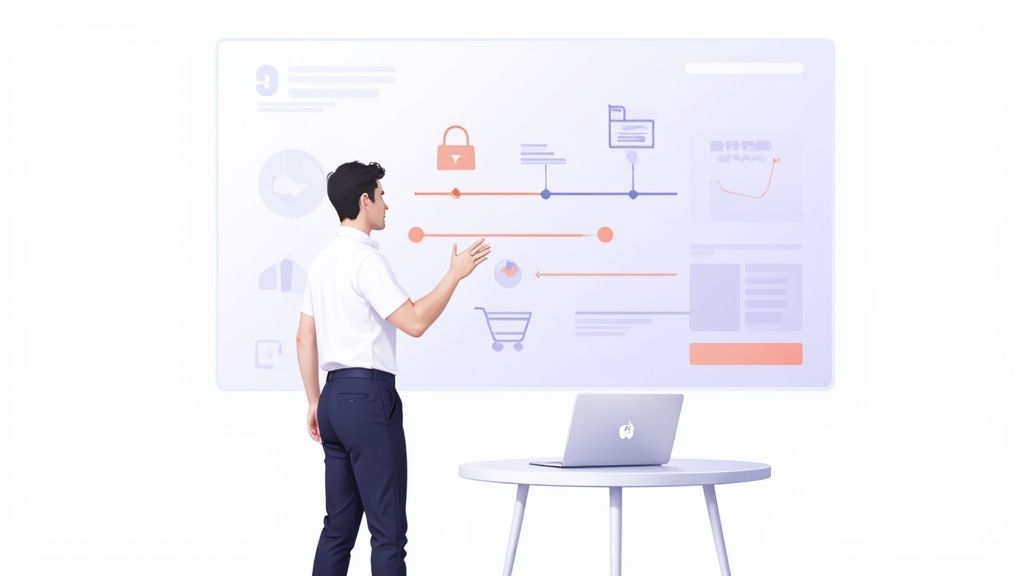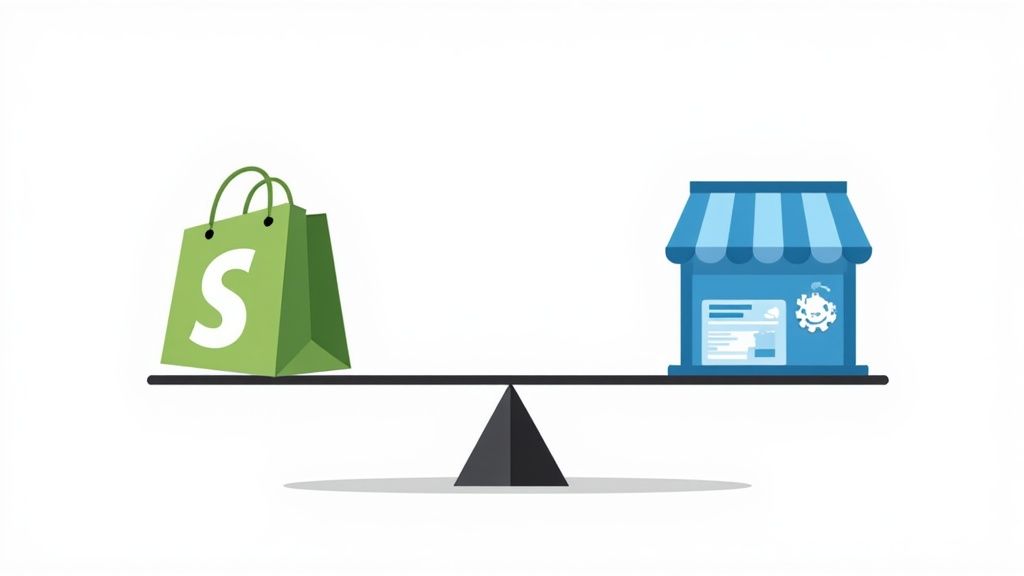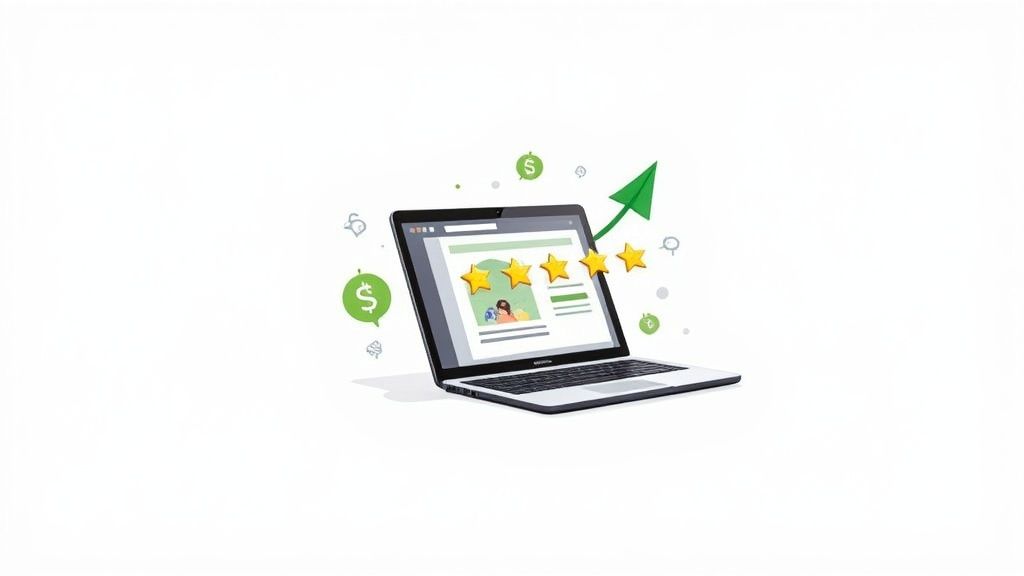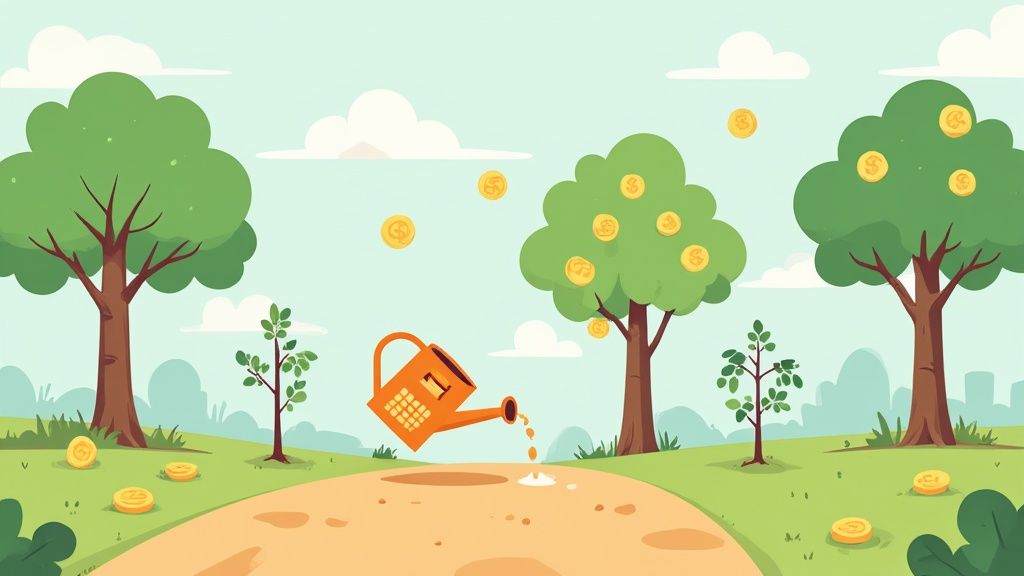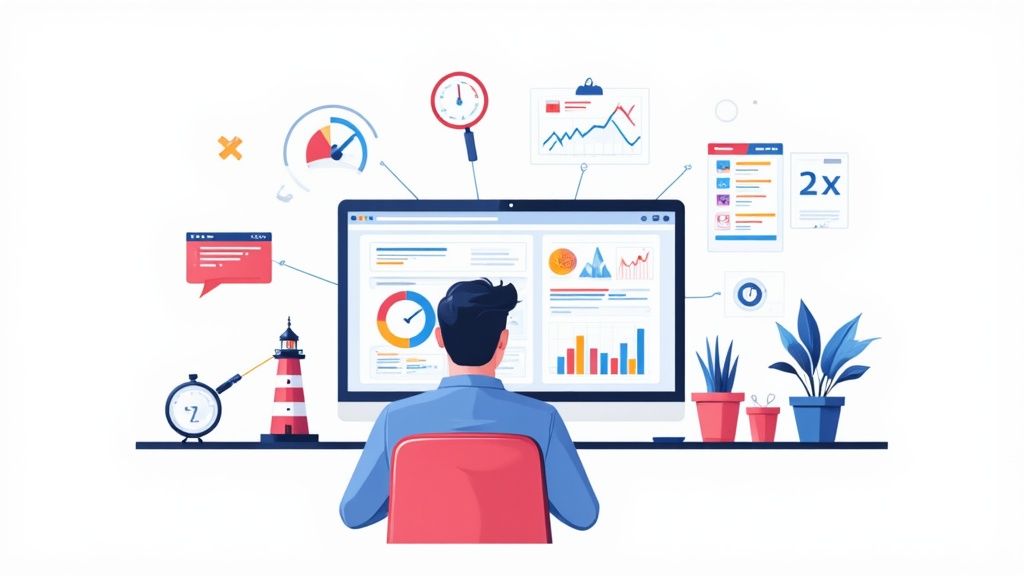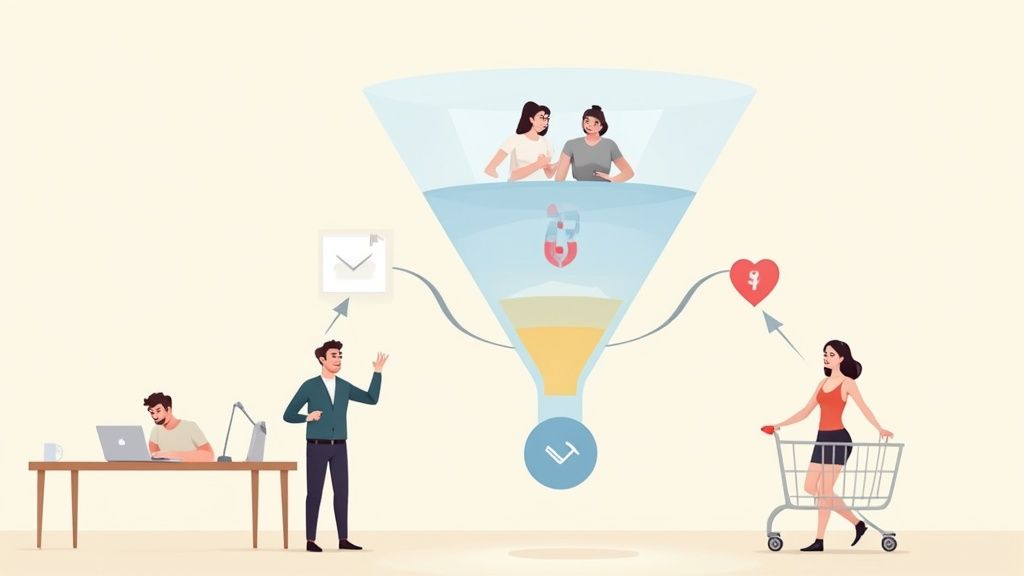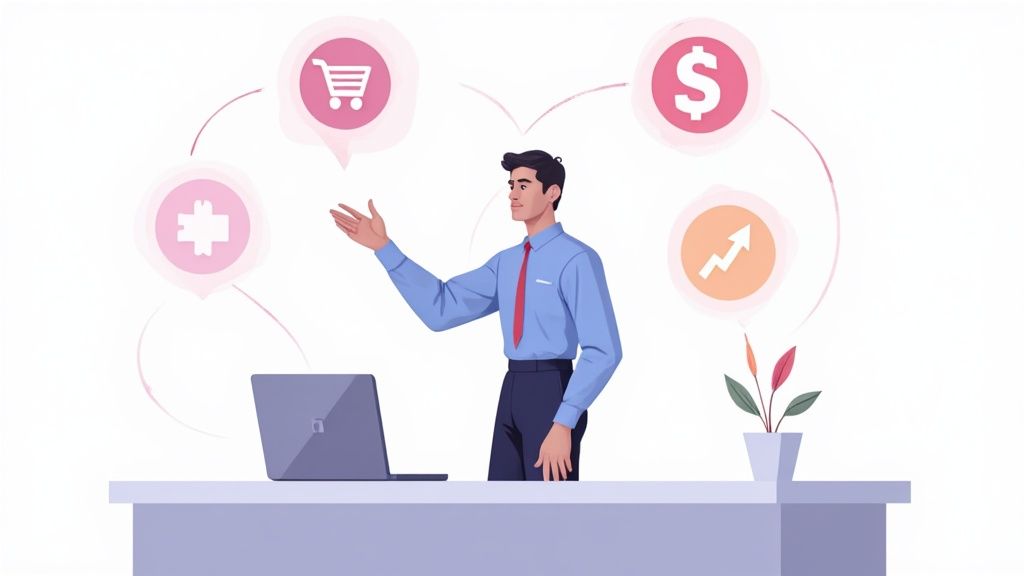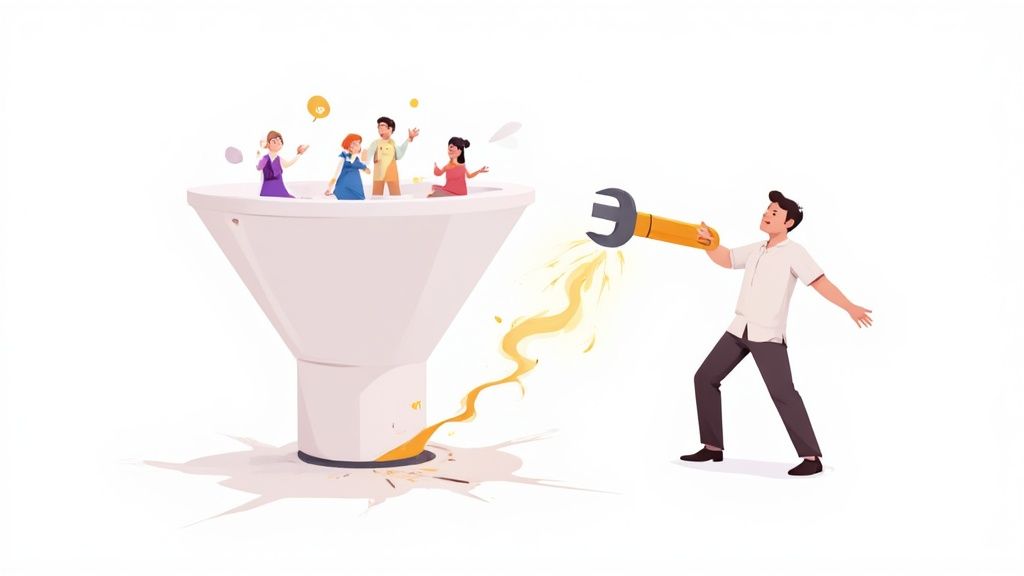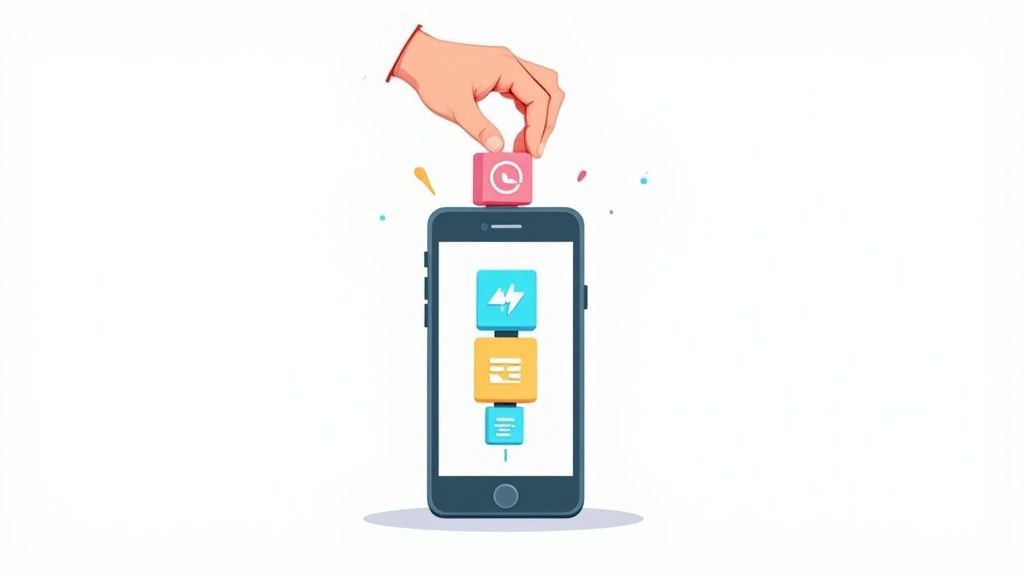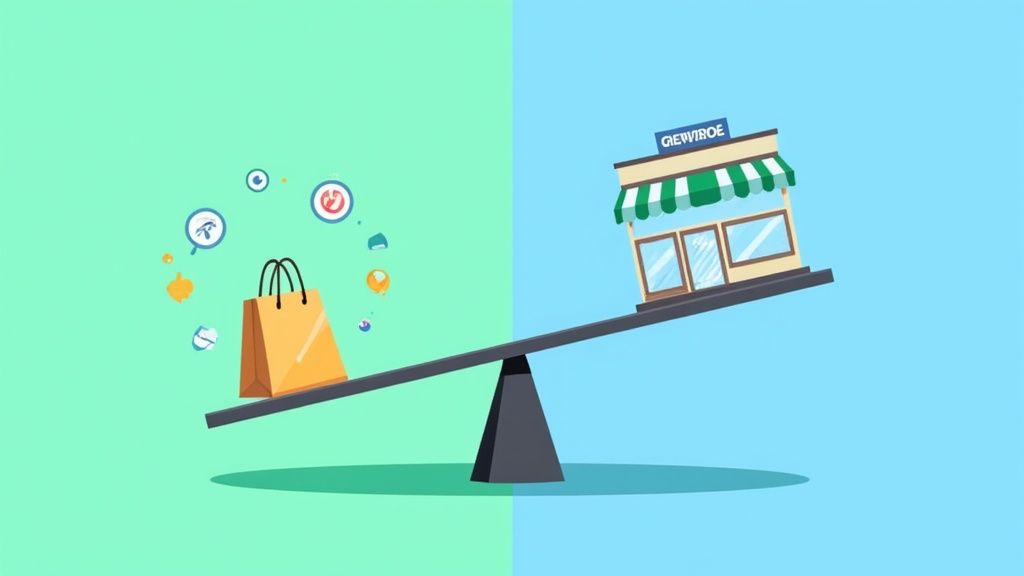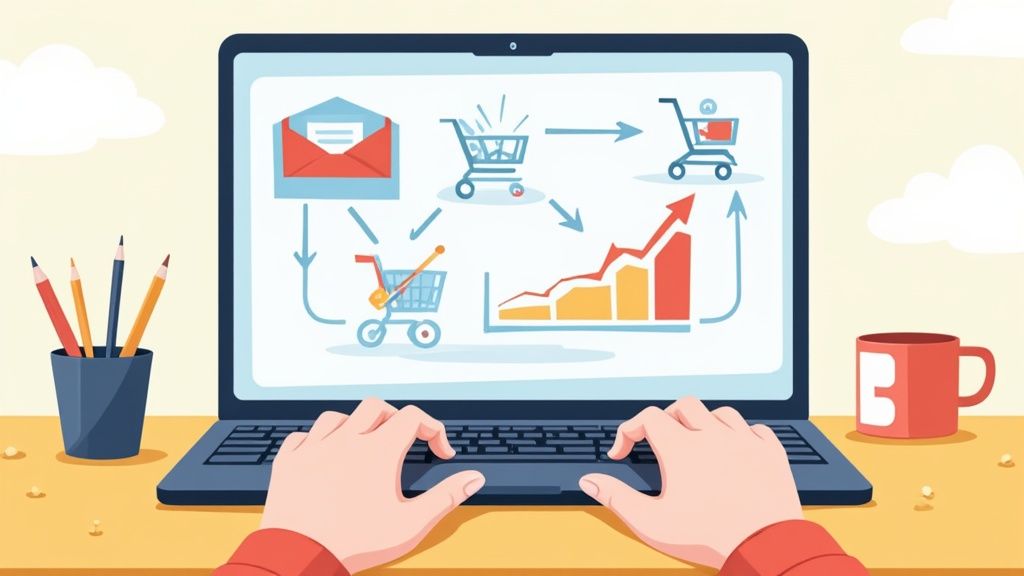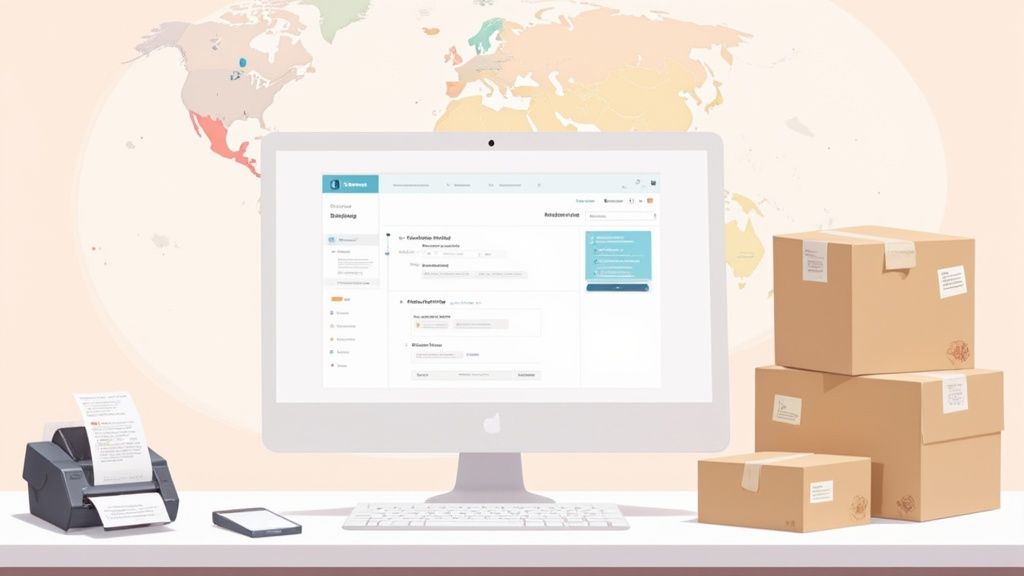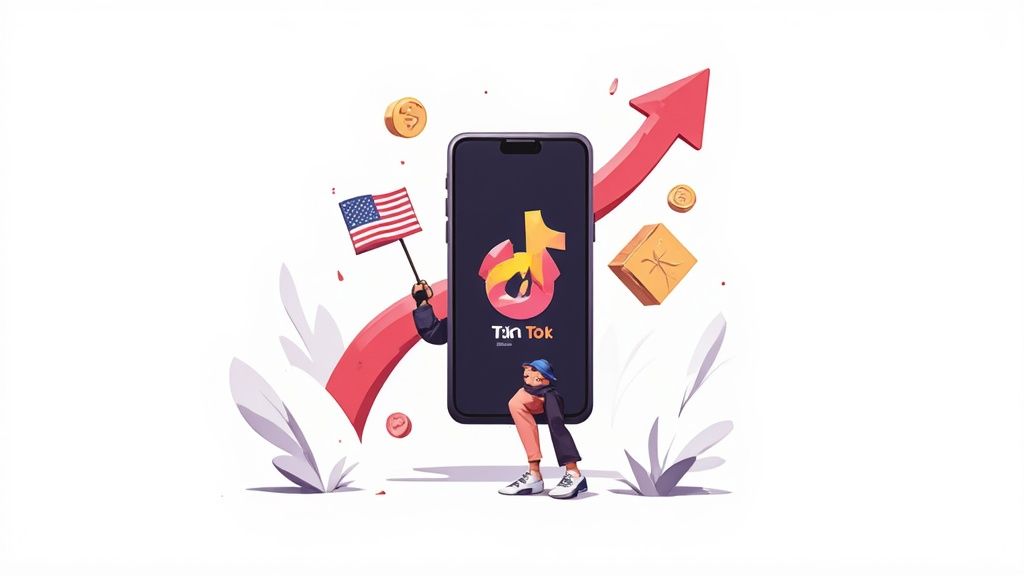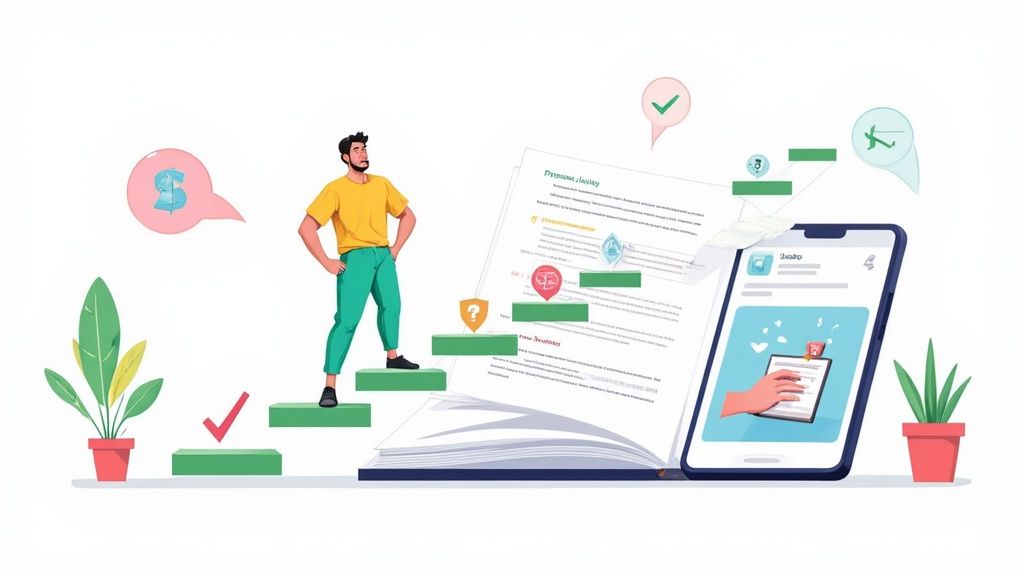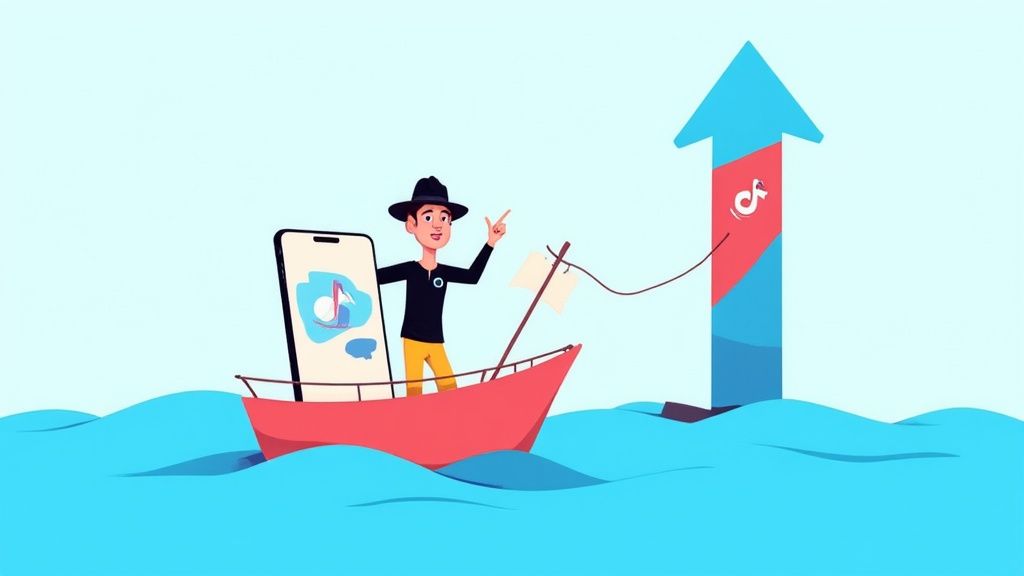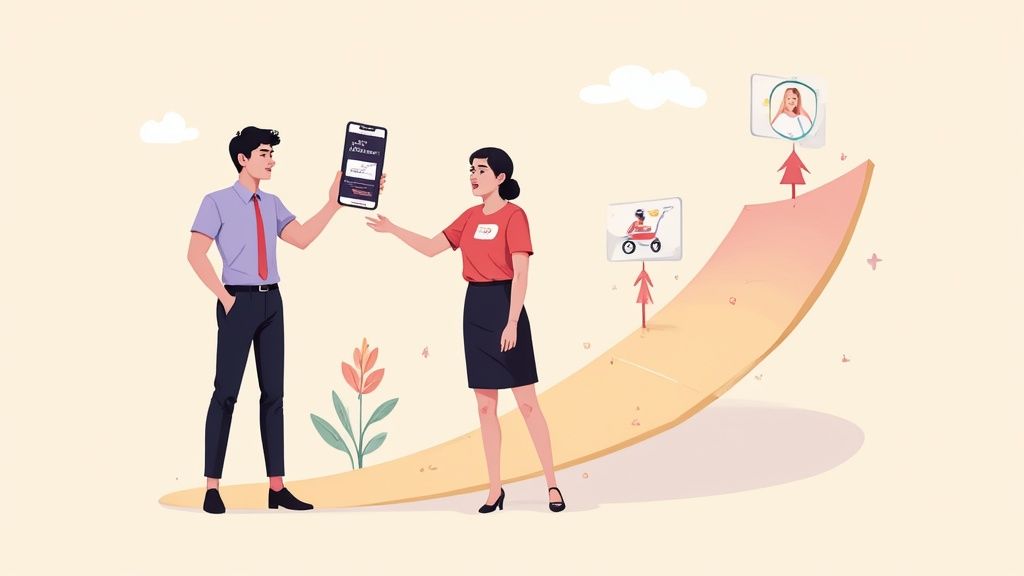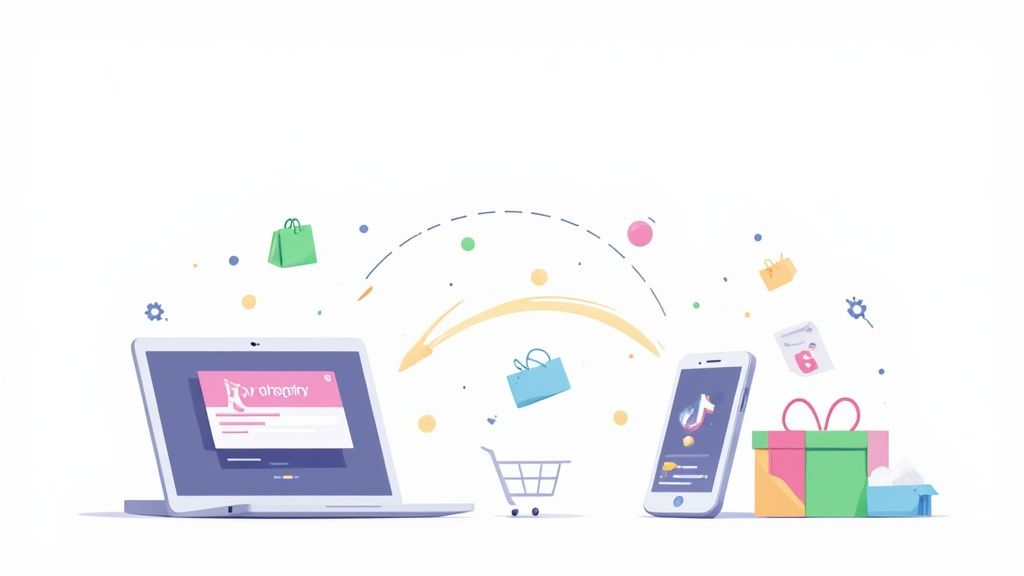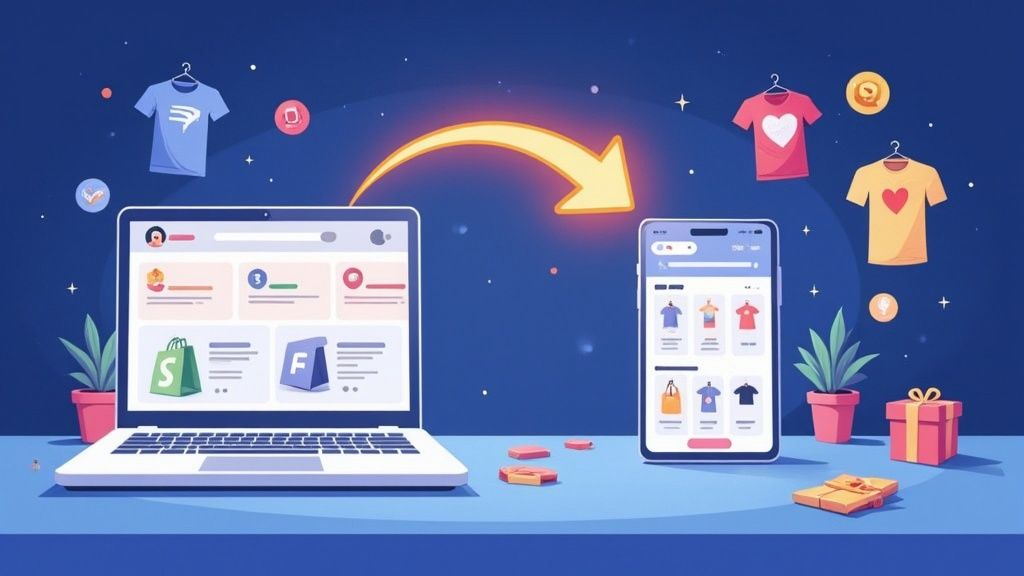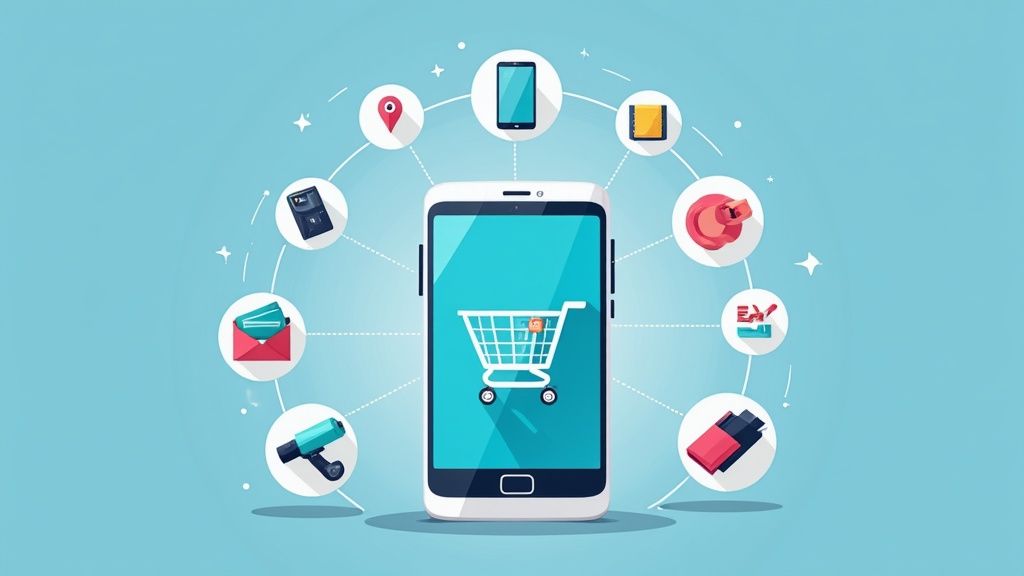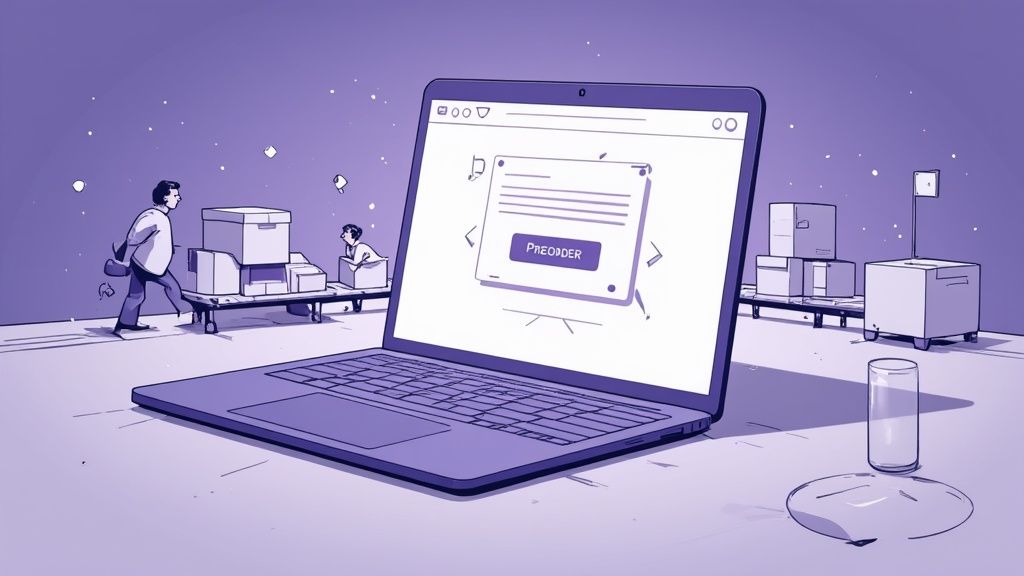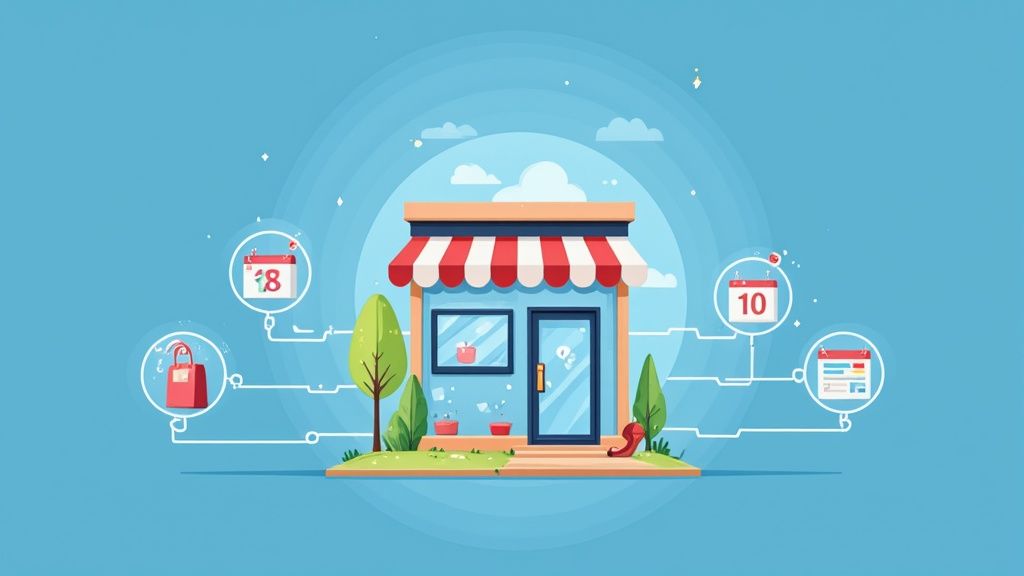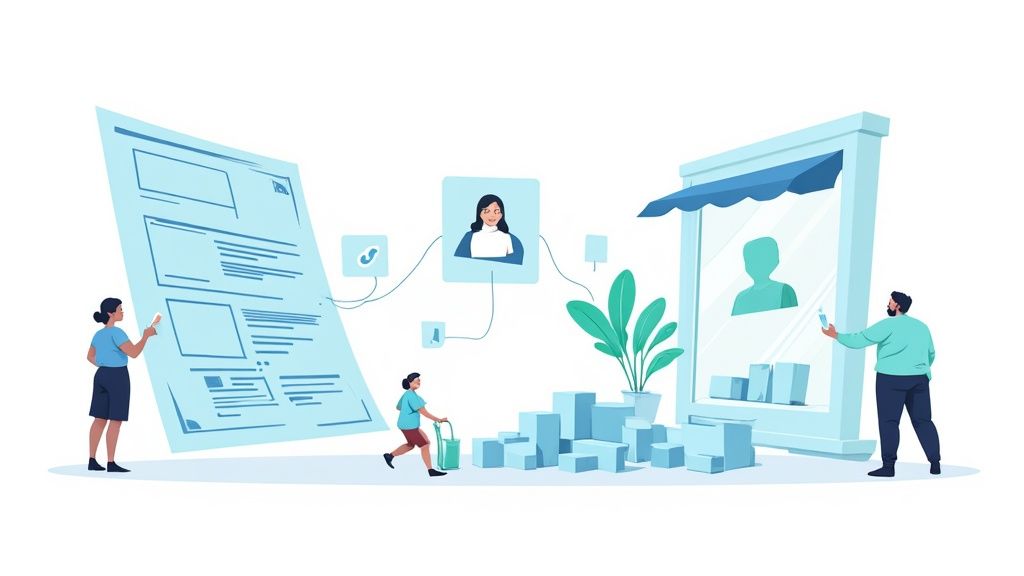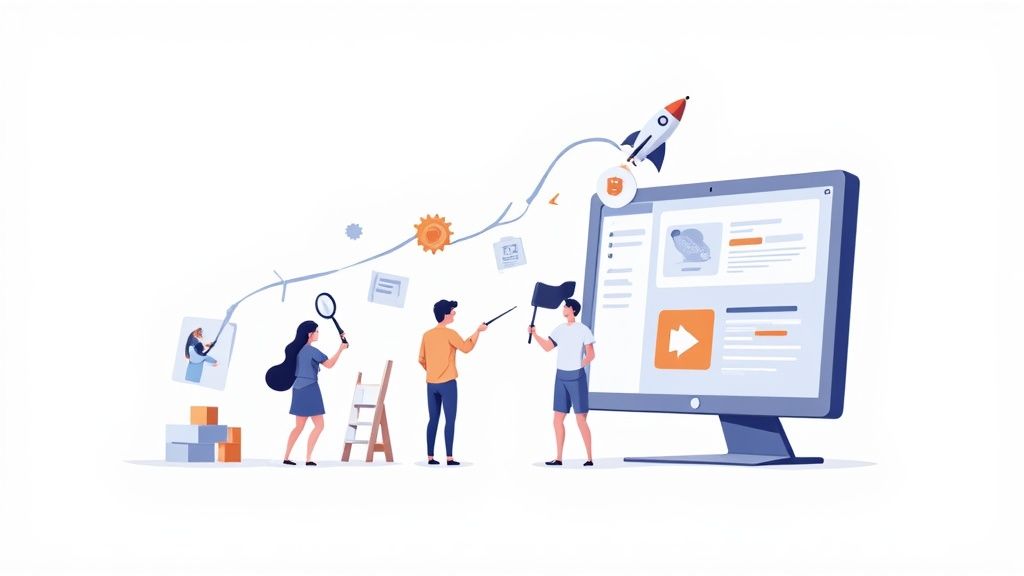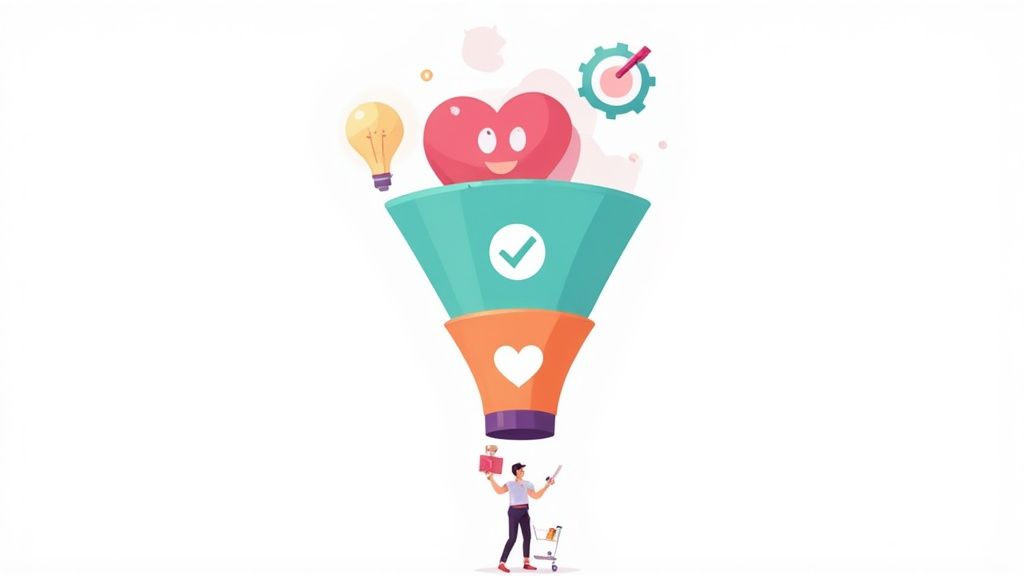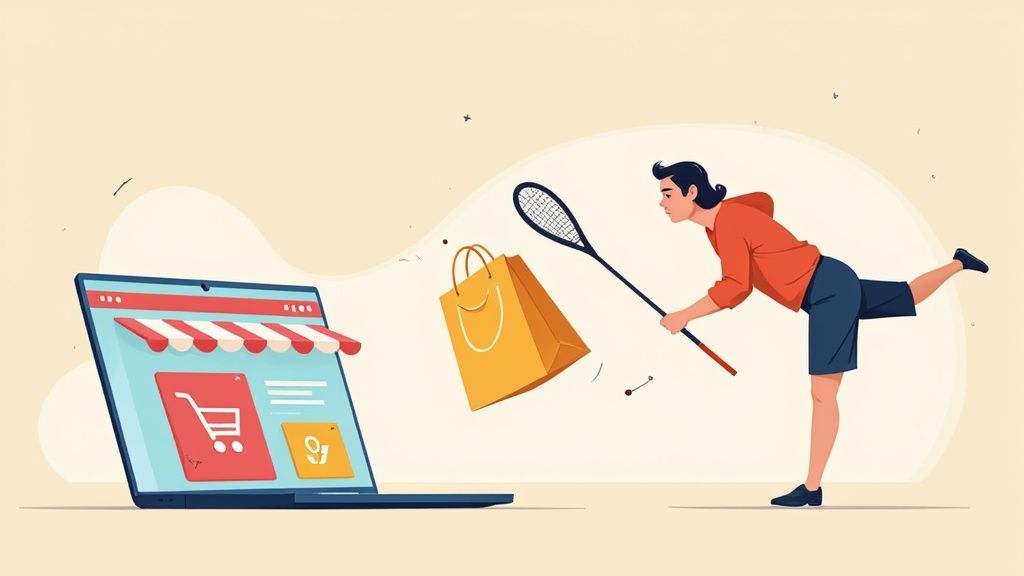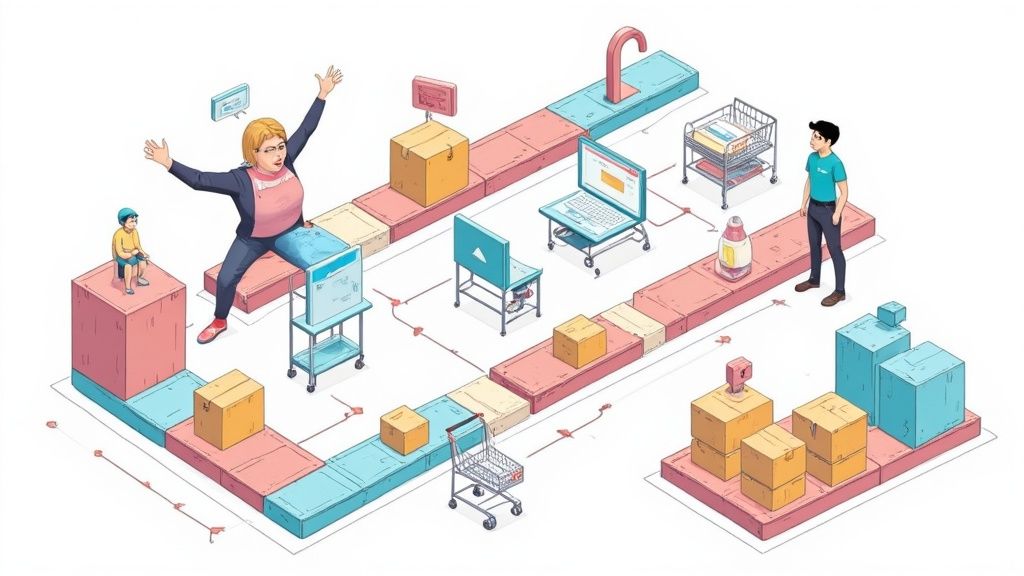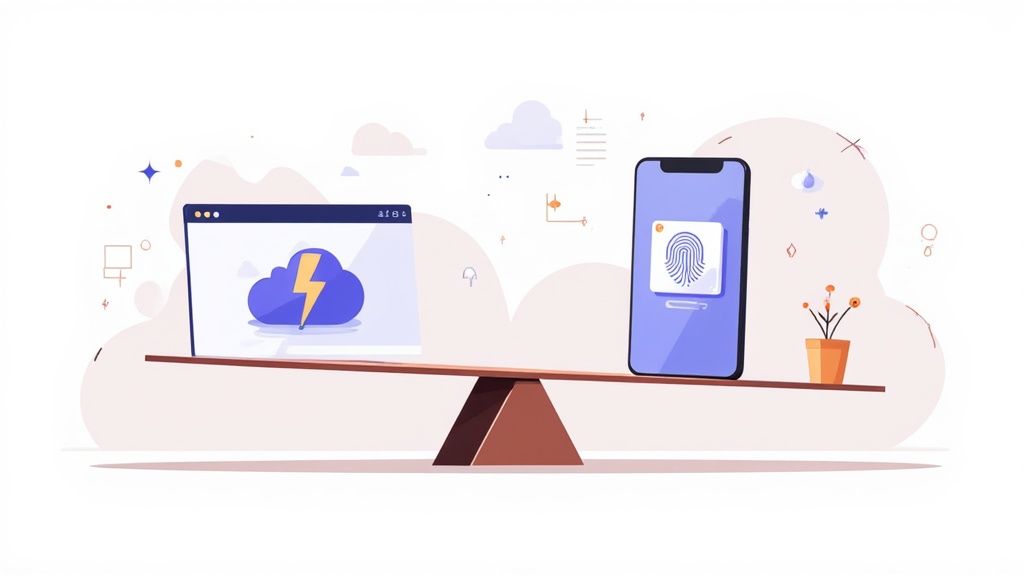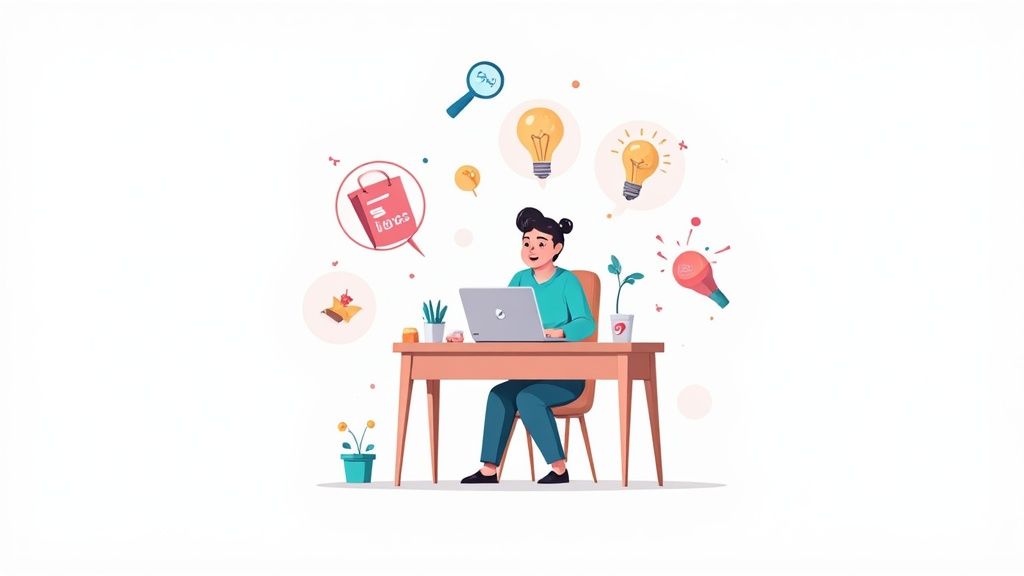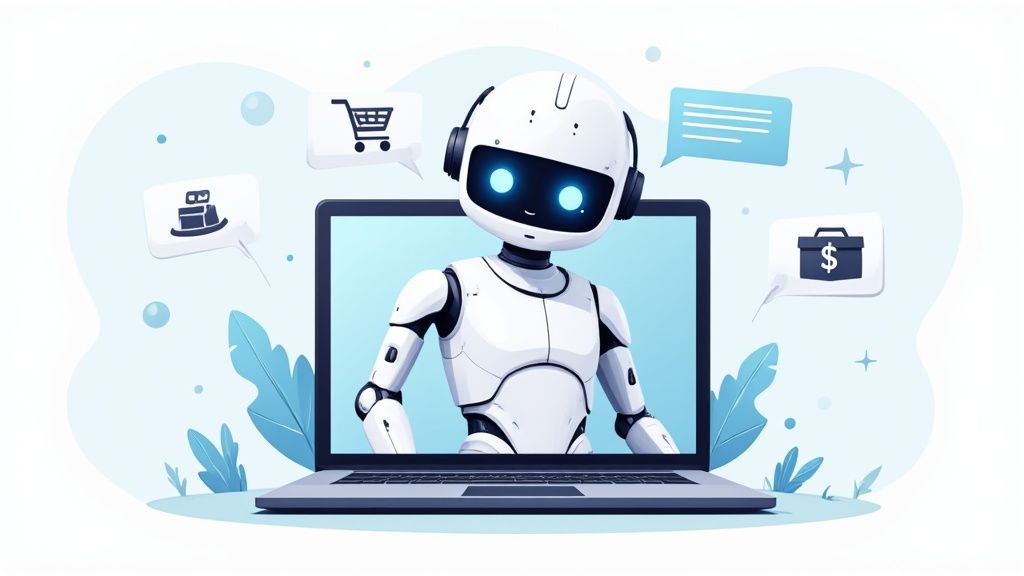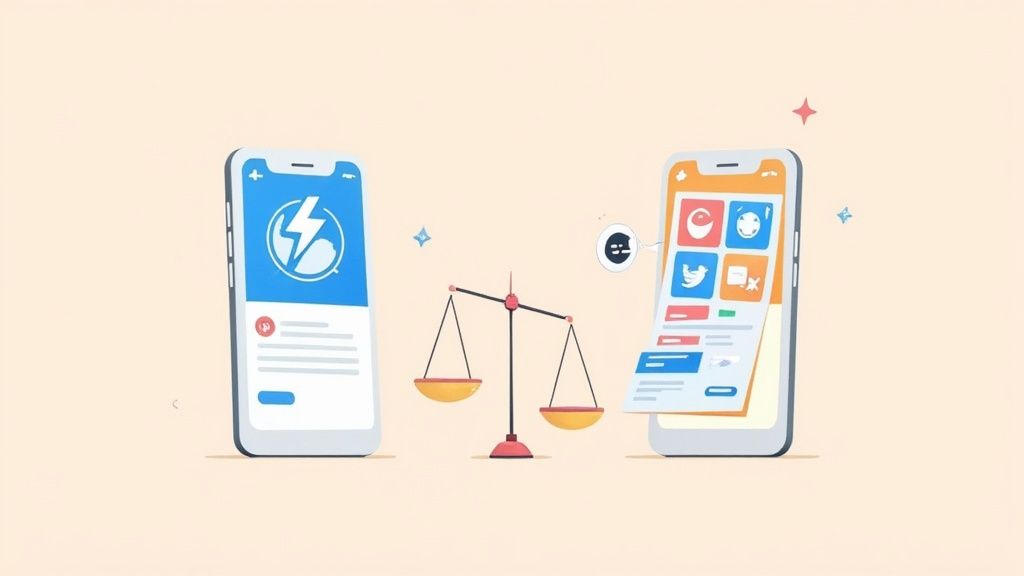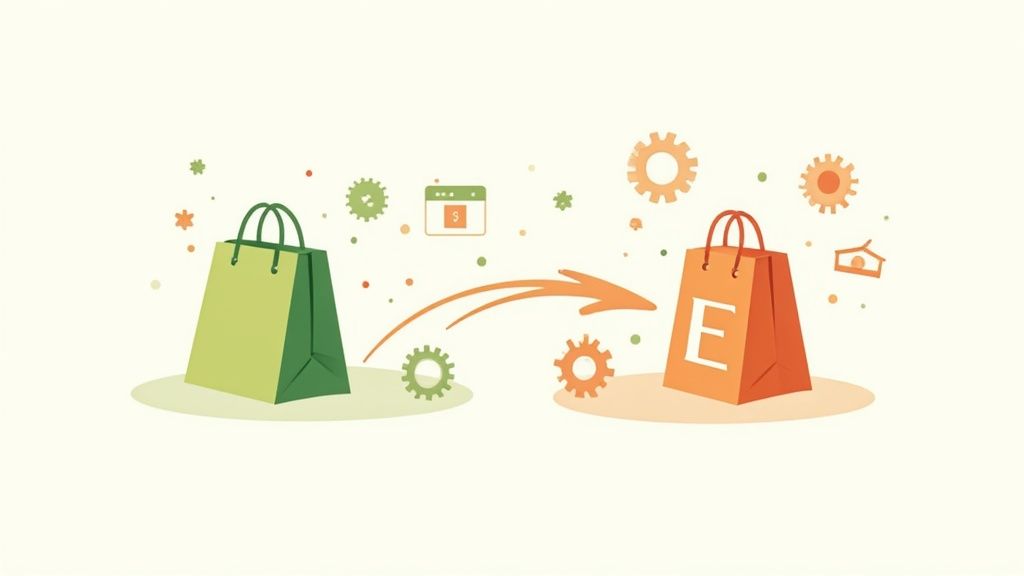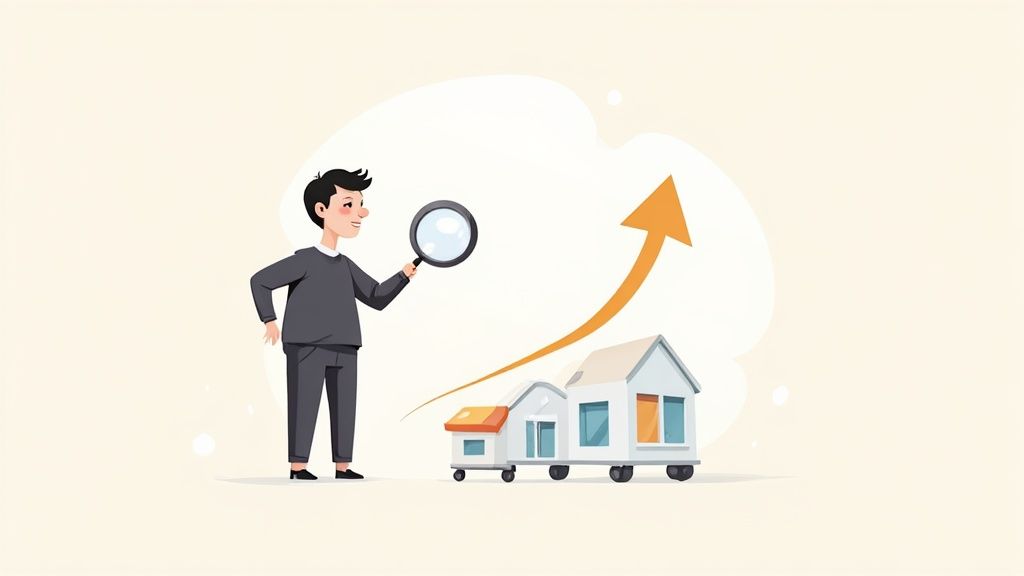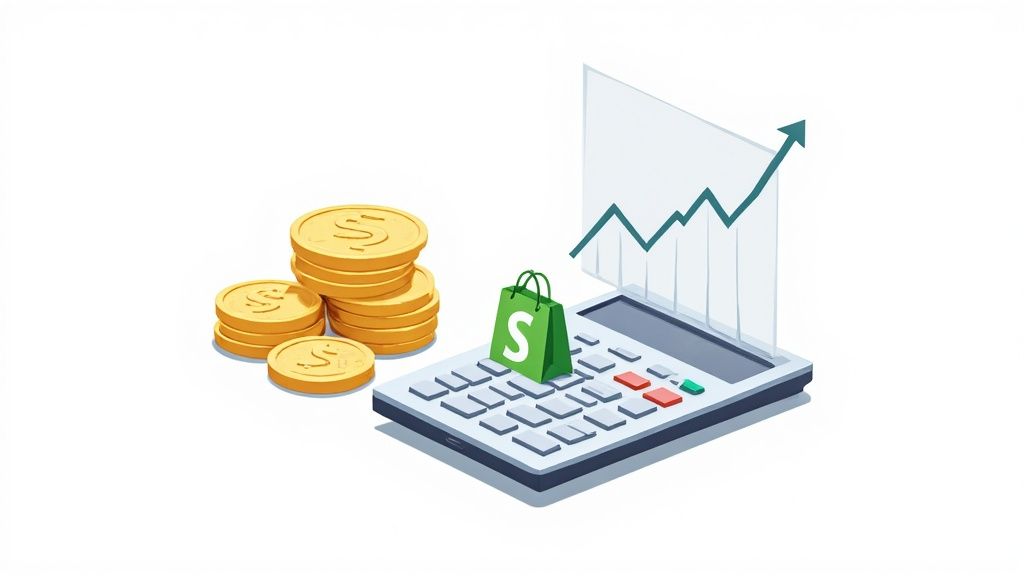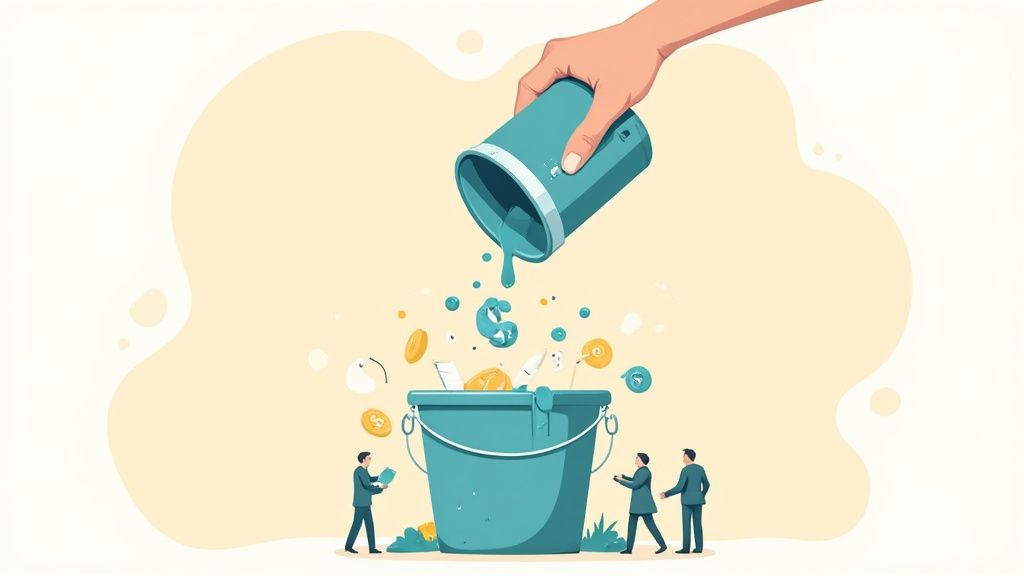
To really get a handle on churn, you first need to understand its true cost. It’s not just about the monthly revenue you lose when a customer cancels. The real damage is that high churn puts you on a hamster wheel, forcing you to constantly replace customers just to keep your head above water. That makes any kind of sustainable growth feel next to impossible.
The True Cost of a Leaky Customer Bucket
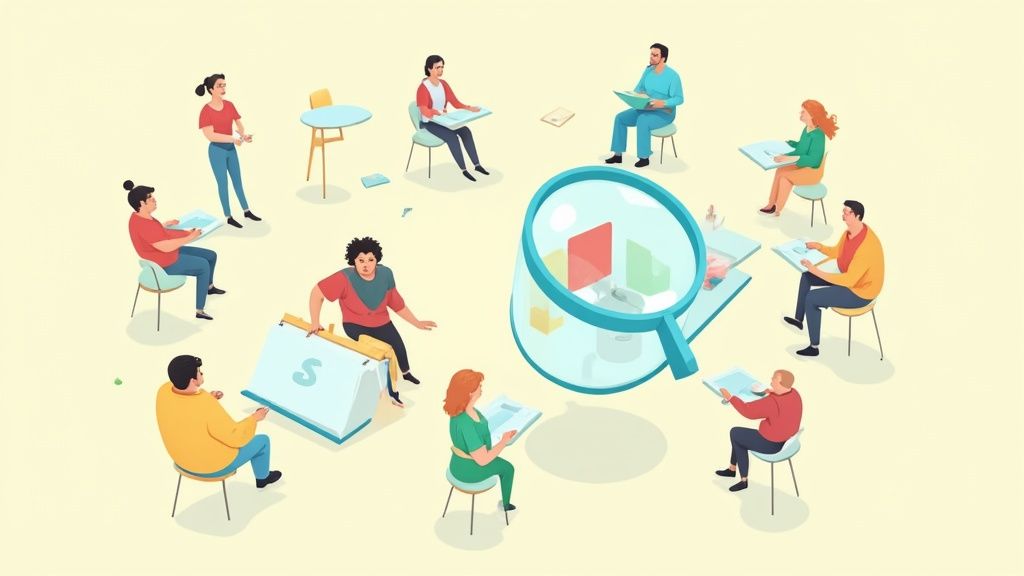
So many eCommerce founders I've worked with are obsessed with customer acquisition. Every new sale is a reason to celebrate. And while bringing in new business is obviously important, this single-minded focus can hide a serious problem: a leaky customer bucket.
Think about it this way. Every dollar you spend on ads, content, and marketing to land a new customer is an investment. When that customer leaves after just one or two purchases, you've essentially thrown that investment away.
It's a huge financial drain. All those resources are just… gone. You end up stuck on a treadmill, running faster and faster just to stay in the same place, never quite achieving the real growth you're aiming for.
The Compounding Effect of Monthly Churn
Even a small monthly churn rate can have a brutal impact on your business over the course of a year. It’s tempting to look at a 3% or 5% churn and think it's no big deal, but the math tells a much scarier story. The losses compound month after month, eroding your customer base faster than you’d ever expect.
This is exactly why getting proactive about churn isn't just a "nice to have"—it's a must. The data doesn't lie. A 5% monthly churn rate might not sound like much, but it means you're losing about 46% of your customer base annually. If that number creeps up to 10% a month, your annual churn can hit a staggering 70%. For most businesses, that's a death sentence.
If you want to dig into the numbers yourself, the 2025 retention report on Churnkey.co is a real eye-opener.
Beyond Lost Revenue: The Hidden Costs
The damage from churn goes way beyond the immediate loss of a sale or subscription fee. It creates a ripple effect of hidden costs that quietly eat away at your profitability and kill your growth potential.
Here are a few of the biggest drains you might not be thinking about:
- Shrinking Customer Lifetime Value (CLV): Every customer who walks away early drags down your average CLV. A lower CLV gives you less wiggle room on acquisition costs, making it that much harder to compete for new customers without losing money.
- Damaged Brand Reputation: Unhappy customers rarely leave quietly. They talk. They post reviews. This negative word-of-mouth can tarnish your brand and scare away potential new customers, creating a nasty feedback loop.
- Decreased Team Morale: Nobody likes dealing with angry customers and constant cancellations. High churn can absolutely crush the morale of your support and success teams, leading to burnout and employee turnover—another hidden cost for the business.
When you start treating churn as a critical indicator of your business's health, you stop just plugging leaks. You start building a stronger, more resilient foundation for the long haul.
Why Your Growth Feels Stagnant
Ever feel like you're putting in more effort than ever but your revenue numbers just aren't moving? High churn is almost always the culprit. It's a massive headwind pushing against everything you're trying to build.
It's the leaky bucket problem in action. For every two new customers you bring in, if one (or more) existing customer leaves, your net growth is tiny, or even negative. You can keep pouring more water (new customers) into the bucket, but it'll never get full if the holes at the bottom are too big.
Fixing your churn rate is how you patch those holes. It’s what finally allows you to start accumulating customers and building real, sustainable momentum. The strategies that follow are designed to help you do exactly that.
Finding Out Why Your Customers Are Really Leaving
To slash your churn rate, you have to put on your detective hat. Guesswork is your worst enemy; a data-backed diagnosis is your best friend. Just throwing generic retention tactics at the wall to see what sticks is an expensive, inefficient way to run a business. The real goal here is to get to the bottom of why your customers are walking away, so you can apply targeted, effective fixes.
This whole process boils down to blending two types of information: the "what" and the "why." Quantitative data tells you what is happening—the cold, hard numbers. Qualitative insights fill in the blanks, telling you why it's happening. When you bring them together, you unlock truly actionable insights.
The image below paints a stark picture of the relationship between churn and retention. It really drives home that even a seemingly small churn rate, like 8%, means a huge chunk of your customer base isn't being retained over time.
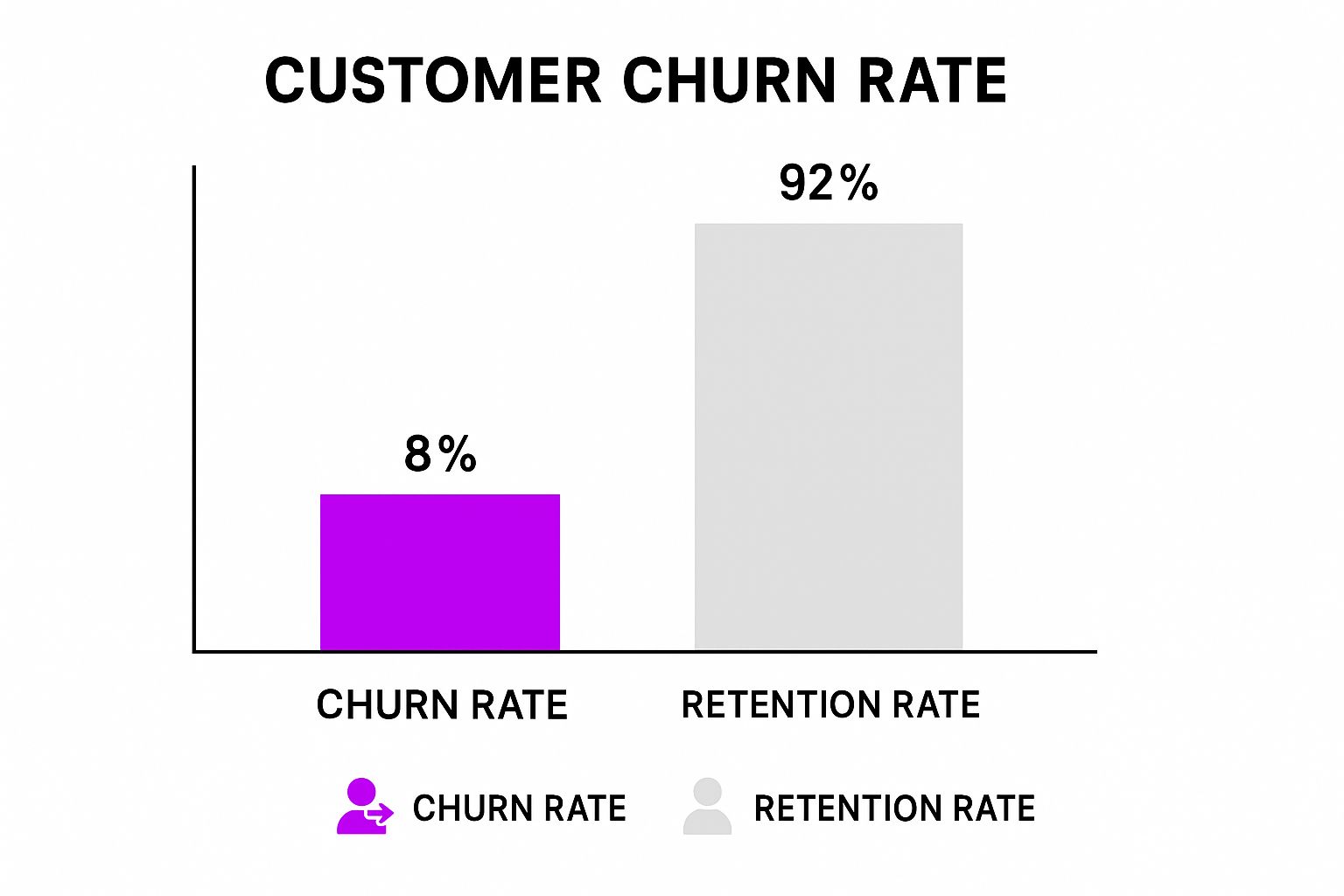
This visual makes it painfully clear: every percentage point in churn represents real people who have stopped giving you their business. This makes your retention efforts absolutely critical for any kind of sustainable growth.
Digging into Quantitative Data
First things first, let's look at the numbers. Your analytics platforms are goldmines of information, packed with clues that can reveal behavioral patterns just before a customer decides to leave. You're not just looking for a single metric; you're piecing together a story told through data points.
Zero in on the key drop-off points in your customer journey. For instance, do you notice a big spike in cancellations after the first 30 days? That could point to a broken onboarding process where customers never get that "aha!" moment and fail to see your product's real value.
Other critical areas to poke around in include:
- Feature Adoption: Are churning customers all ignoring a specific feature that your most loyal customers use every day? That smells like a value gap.
- Usage Frequency: A sudden or even a gradual decline in logins or activity is one of the most reliable red flags for churn.
- Support Ticket Volume: A surge in support tickets from a customer, especially if they aren't resolved quickly, often signals mounting frustration.
By segmenting your churned customers, you can uncover incredibly powerful patterns. Are they mostly coming from a specific marketing channel? Did they all buy one particular product? Answering these questions shifts your focus from a vague problem ("high churn") to a specific one ("customers we get from paid social are churning right after their first purchase").
This is the kind of detail that turns your churn reduction efforts from a shot in the dark into a calculated, strategic move. It lets you treat the root cause, not just the symptom.
Uncovering Qualitative Insights
Numbers tell you what, but they almost never tell you why. For that, you need to actually talk to people. Qualitative feedback gives you the human context behind the data, revealing the frustrations, motivations, and unmet expectations that push customers to cancel.
The most direct way to get this information is with exit surveys. When a customer starts the cancellation process, pop up a simple, multiple-choice question asking why they're leaving. Keep it short and sweet to get the highest completion rate possible.
But don't stop there. For high-value customers who churn, a personal email or even a quick phone call can provide priceless, unfiltered feedback. It's a small gesture that not only gives you insight but also shows you care, which can leave the door open for them to come back down the road.
Recent analysis of nearly three million cancellation sessions shows that churn is often driven by practical concerns like budget constraints or simply not using the product enough, rather than pure dissatisfaction. This is a huge insight—it highlights the need for businesses to address financial friction and keep customers engaged. You can learn more about these retention findings at Churnkey.co to really understand these drivers.
Combining Data for a Clear Picture
The real magic happens when you merge these two streams of data. For example, your analytics might show that customers who don't use "Feature X" are 80% more likely to churn. Then, your exit surveys reveal that customers think "Feature X" is just too complicated to set up.
Boom. Suddenly, you have a crystal-clear, actionable path forward: simplify the onboarding for "Feature X" with better tutorials, in-app guidance, or a setup wizard. This is a targeted solution that directly attacks a known reason for churn.
To get started, it helps to have a framework for spotting your biggest churn drivers. This table breaks down some of the most common issues and how you can start diagnosing them in your own business.
Common Churn Drivers and How to Identify Them
By systematically figuring out why your customers are leaving, you're building the foundation for a much smarter, more effective retention strategy. Now you can move forward with confidence, knowing your efforts are aimed squarely at the right problems.
Designing an Onboarding Experience That Sticks
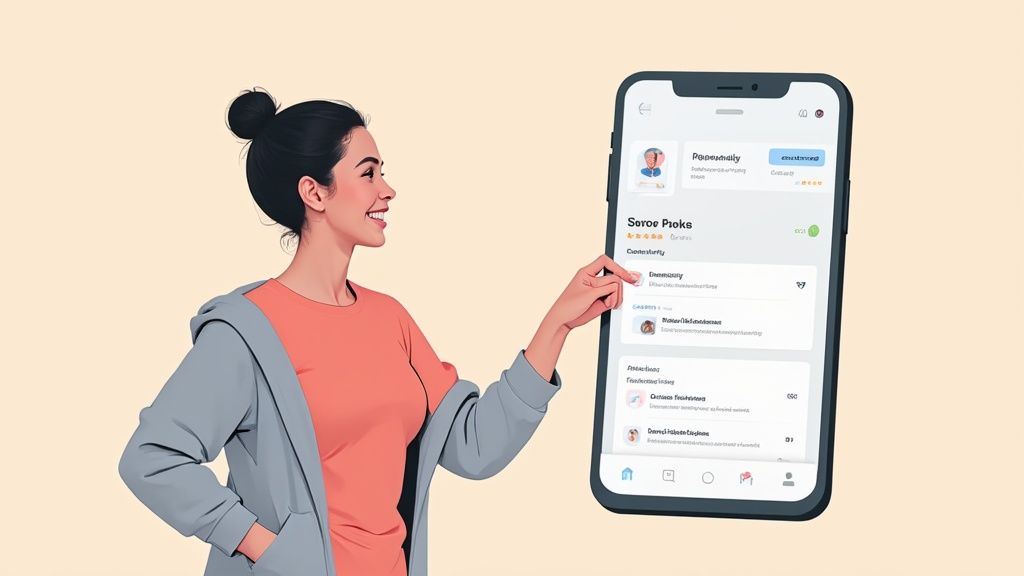
It's a painful truth, but a huge amount of customer churn happens right after a purchase or sign-up. That initial excitement a customer feels can fizzle out fast. If they feel lost, confused, or just plain overwhelmed, they’re gone before you ever get a chance to prove your worth. This early-stage churn is almost always the direct result of a broken or nonexistent onboarding process.
To get a real handle on your churn rate, you absolutely have to nail the "first mile" of the customer journey. This is that critical window where you guide a new user from their initial sign-up to their first taste of success—that all-important "aha!" moment where they truly get the value you bring to their life.
Without a structured onboarding experience, you're basically leaving customer success to pure chance. A strong process, however, makes new users feel capable, supported, and confident that they made the right choice.
The Power of the First "Aha!" Moment
The "aha!" moment is that lightbulb-flickering-on instant when a user suddenly grasps your product's core value. For a project management tool, it might be when they successfully create and assign their first task. For an eCommerce analytics app, it’s that first report that gives them a genuinely new insight into their sales.
Your entire onboarding flow should be engineered to get customers to this point as quickly and smoothly as possible. This isn't about throwing every single feature you have at them; that’s a classic recipe for sending them running. Instead, it's about laser-focusing on the one or two key actions that deliver immediate value.
One of the most effective ways to structure this is by creating a clear, step-by-step path. For example, a well-defined client onboarding checklist can provide a systematic framework to ensure no new customer ever falls through the cracks. It sets clear expectations right from the start.
A study by Wyzowl found that 68% of users would be more loyal to a business that invests in great onboarding and education. This isn't just about a friendly welcome; it's a direct driver of long-term retention.
Personalizing the Onboarding Journey
A one-size-fits-all onboarding experience is a massive missed opportunity. Your customers show up with different goals, different levels of technical skill, and different expectations. By personalizing their first few interactions, you can address their specific needs and make the whole process feel more relevant and helpful.
Here are a few personalization tactics I've seen work wonders:
- The Welcome Survey: Ask a few simple questions right at sign-up. "What's your primary goal with our product?" or "What's your role?" The answers can then trigger entirely different onboarding paths.
- Segmented Welcome Emails: Ditch the generic welcome email. Create a few versions tailored to your main user personas. A founder might get an email focused on ROI, while a marketer gets one that highlights campaign tracking features.
- Behavior-Triggered Tooltips: Use in-app messages that pop up based on what a user does (or doesn't do). If someone hasn't invited a teammate after three days, a small tooltip could appear explaining the benefits of collaboration.
This level of personalization shows you actually understand your customer's context, which immediately starts building a stronger relationship and makes them far less likely to churn.
Building In-App Guidance That Actually Helps
The best onboarding doesn't happen in a long-winded email or a separate PDF guide. It happens right inside your product. In-app tutorials are your most powerful tool for teaching users while they’re actively engaged. Unfortunately, this is where a lot of companies get it wrong.
Please, avoid the dreaded "20-step product tour" that forces users to click through every single button on the screen. It’s annoying, and people forget everything the second the tour is over. It's just not effective.
Instead, focus on interactive, contextual guidance that helps them accomplish something real.
Effective In-App Guidance Examples:
By making onboarding an integrated and genuinely helpful part of the experience, you empower customers to succeed on their own terms. That confidence is the bedrock of retention and a powerful way to crush churn from day one.
Keeping Customers Engaged and Listening Actively
In the world of eCommerce, silence is rarely golden. A quiet customer isn't necessarily a happy one; more often than not, they’re disengaged and slowly drifting toward a competitor. If you really want to reduce churn rate, you have to stop just reacting to problems and start proactively building relationships.
It's about shifting your mindset. You need to keep the conversation going and deliver value even when they aren't actively shopping. This consistent, helpful engagement reinforces their choice to buy from you, making them feel seen and appreciated long after that initial transaction.
Opening Up Proactive Lines of Communication
Keeping your brand top-of-mind doesn't mean you have to be annoying. The trick is sending the right message, on the right channel, at just the right moment. This isn't about spamming inboxes—it’s about thoughtful touchpoints that genuinely help.
Here are a few multi-channel tactics I've seen work wonders:
- Smart Email Sequences: Think beyond the standard order confirmation. Send an email triggered by their behavior, like a quick guide on how to care for a product they just bought. Or, check in 30 days later to see how they're liking their purchase.
- Timely SMS or In-App Messages: If you have a mobile app or an SMS list, use it for high-impact moments. A quick text letting a customer know that an out-of-stock item they were eyeing is back is a perfect example. It's helpful, not salesy.
- A Hub for Valuable Content: A blog or a "Success Center" is a fantastic way to give customers a reason to visit your site besides just buying something. Share content that helps them get more out of your products, and you'll position yourself as the go-to expert.
This approach turns your communication from a sales pitch into a genuine service, strengthening that customer bond with every interaction.
Building a System for Actually Listening
To figure out what your customers really want, you can't just wait for the occasional support ticket or social media mention to roll in. You have to build a system that actively asks for their opinions. This is how you spot friction points before they fester into reasons for leaving.
Simply put, you can’t fix a problem you don’t know exists. By making it incredibly easy for customers to share their thoughts, you turn feedback from a rare event into a continuous stream of actionable insights.
The best feedback systems are dead simple for the customer and systematic for your team. You don't need to overcomplicate it. Start with a couple of core methods, like Net Promoter Score (NPS) surveys. Sending a simple "How likely are you to recommend us?" email after a purchase or a support chat gives you a clear, quantifiable pulse on customer sentiment.
The insights you gather are pure gold. For example, Coca-Cola HBC has successfully cut down churn by creating frequent touchpoints to gather feedback before a customer even thinks about churning. This proactive approach is a game-changer, especially in competitive industries like wholesale and CPG. You can dig into how different sectors handle churn over at CustomerGauge.com.
Turning That Feedback into Real Action
Collecting feedback is just step one. The real magic happens when you act on it. When a customer takes time out of their day to give you their thoughts, they expect to be heard. Closing the loop isn't optional—it's how you show you're listening and are committed to making things better.
Here’s a simple framework for putting feedback into play:
- Sort and Spot Trends: Don't just let feedback pile up in an inbox. Tag and categorize every piece of it, whether it’s from a survey, an email, or a public review. Look for patterns. Are lots of people complaining about shipping times? Is a certain product page causing confusion?
- Assign Ownership: Make someone on your team responsible for following up. For negative feedback, a personal reach-out from a customer success manager can completely turn a bad experience around and build incredible loyalty.
- Shout About Your Changes: When you make an improvement based on customer feedback, let people know! Send a quick email to the customers who brought up the issue. A simple, "Hey, we listened and made this change because of you," is incredibly powerful.
This process proves that speaking up actually leads to results. It’s one of the best ways to build trust and show customers that their relationship with your brand is a two-way street. This commitment to listening and following through is a cornerstone of any strategy to reduce churn rate.
Using Smart Incentives to Win Back At-Risk Customers
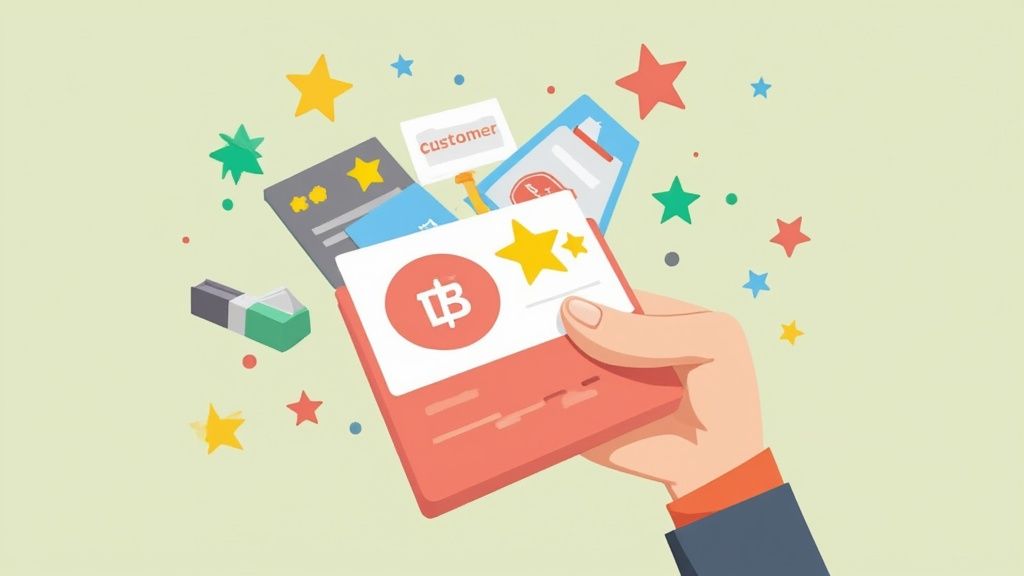
When you see the classic signs of a customer slipping away—maybe they're logging in less or their engagement has dropped off a cliff—your first instinct might be to panic and throw a big discount at them. That's a purely reactive move, and honestly, it's a great way to eat into your margins and teach your customers that your product isn't worth full price.
A much savvier play is to step in with personalized, perfectly timed incentives that actually solve a problem. The real goal isn't just to stop them from clicking "cancel." It's to give them a compelling reason to stay by reminding them of the value they saw in the first place. This is how you reduce churn rate without getting into a price war you can't win.
Crafting Offers That Actually Work
Forget the one-size-fits-all "15% off!" emails. They rarely get to the heart of the issue. The most powerful incentives are the ones that feel like they were created just for that specific user. Before you dream up an offer, you need to dive into their behavioral data. Why do you think this customer is about to leave?
If someone has completely stopped using a key feature, a generic discount is useless. It doesn't fix their problem. A far better approach would be to offer a free one-on-one strategy session with a product expert. This adds tangible value instead of just slashing the price.
Here are a few targeted ideas that go way beyond simple discounts:
- Temporary Plan Upgrade: Give them a free, limited-time taste of a higher-tier plan. Let them experience premium features they might not even know exist. This can forge a new, stickier connection to your product.
- A "Pause" Option: Life happens. Sometimes customers just need a break. Offering the ability to pause their subscription for a month or two—either for free or a small fee—is often enough to prevent a permanent cancellation.
- Targeted Service Credits: Did a customer have a rough support experience? A service credit automatically applied to their next bill is a powerful way to say "we messed up, and we want to make it right," rebuilding trust in the process.
The Psychology Behind Smart Incentives
The best incentives aren't just about the money; they tap into some powerful human psychology. A well-crafted offer makes a customer feel seen, understood, and even a little special, which does wonders for their emotional connection to your brand. The principle of reciprocity is huge here. When you give them something of unexpected value, they feel a natural urge to give back—in this case, with their loyalty.
It's not about making a desperate plea to stay. It's about making a compelling case for why staying is the best choice for them. A smart incentive shifts the conversation from "please don't go" to "here's how we can make this work even better for you."
This kind of strategic thinking is absolutely essential for any eCommerce brand. Customer turnover is a constant battle. To put it in perspective, online retail churn was around 22% back in 2020, which shows just how fierce the competition is. Even major electronics retailers, which have a lower churn of about 11%, still have to fight tooth and nail for every customer. You can check out more of these industry churn benchmarks on BloggingWizard.com.
Your Last Best Chance to Change a Mind
Even with the best prediction models, some customers are going to head for the exit. This is where your off-boarding flow becomes your final line of defense. Don't just show them a bland "Your subscription has been canceled" message. Use this moment as one last, critical opportunity to get feedback and present a last-ditch offer.
Your cancellation survey is your most important tool here. Ask a simple, multiple-choice question: "Why are you leaving?" Based on their answer, you can trigger a highly relevant, automated offer.
- "It's too expensive": Instantly present a personalized discount or an option to downgrade to a more affordable plan.
- "I'm not using it enough": Offer the option to pause their subscription for a few months.
- "I couldn't figure out how to use it": Counter with an offer for a free, one-on-one training session.
This targeted, real-time approach dramatically boosts your odds of saving that customer. For a deeper dive into setting up these retention systems, take a look at our detailed guide on customer retention for eCommerce, which is packed with more tactics to keep your customers loyal and engaged.
Frequently Asked Questions About Reducing Churn
When you start digging into churn reduction, a lot of questions pop up. It's natural. Getting straight answers is the first step to building a retention strategy that actually moves the needle for your store. Let's tackle some of the most common ones I hear from clients.
What Is a Good Customer Churn Rate?
This is the million-dollar question, isn't it? The most honest answer I can give is: it depends. A "good" churn rate isn't a single magic number. It swings wildly depending on your industry, business model, and how long you've even been around.
For example, a B2B SaaS company might feel pretty good about a 3-5% monthly churn rate. But for an eCommerce store selling everyday consumer goods, that number would look completely different.
Churn rates can be all over the map. The wholesale sector has seen median churn as high as 56%, while some CPG brands get it down to 9.6%. These stats highlight why you absolutely have to benchmark against your own industry. The real goal is to see that number consistently trending downward, month after month. You can find more detail on these industry benchmarks on CustomerGauge.com.
Should I Offer Discounts to Every Canceling Customer?
Definitely not. It's tempting to throw a coupon at every customer heading for the exit, but it's a slippery slope. You might save a sale today, but you risk devaluing your products and teaching customers to threaten cancellation just to snag a deal.
The smarter play is a targeted one. You need to segment your customers based on their lifetime value and why they're leaving.
- A high-value, long-term customer who suddenly has budget issues? That's a perfect candidate for a personalized, significant discount.
- A user with low engagement who never really got started? A discount won't fix that. They might be better served with an offer to pause their plan or a quick strategy call to help them see the value they're missing.
This approach protects your margins and makes sure you're solving the actual problem. For more on this, check out our guide on how to build customer loyalty and keep the right customers around.
The goal isn't just to stop a cancellation; it's to reinforce the value of your brand. A targeted offer shows you understand the customer's specific situation, which builds more goodwill than a generic coupon ever could.
How Long Until Churn Reduction Efforts Show Results?
Patience is a must when you're working to reduce churn rate. You won't see your overall churn metric drop overnight. The timeline really hinges on the specific strategies you put in place.
Some changes will show results much faster than others. Think of it in two waves:
- Quick Wins (1-2 Months): Things like overhauling your onboarding flow to get users to that "aha!" moment quicker can show a drop in early-stage churn within a month or two.
- Long-Term Impact (3-6+ Months): Bigger, foundational strategies take time. Building a customer community or implementing deep feedback loops are about strengthening relationships. That kind of trust-building takes a few quarters to truly show up in your overall churn numbers.
If you're looking for more strategies to prevent customers from leaving, this comprehensive guide on reducing churn rate is a fantastic resource.
At ECORN, we know that reducing churn is about more than just plugging leaks; it's about building a stronger, more resilient eCommerce business. Our team of Shopify and CRO experts can help you implement the strategies that turn one-time buyers into lifelong fans. Discover how our flexible solutions can help you grow.






